
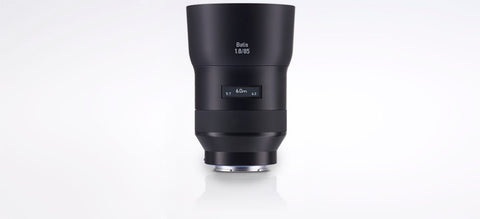
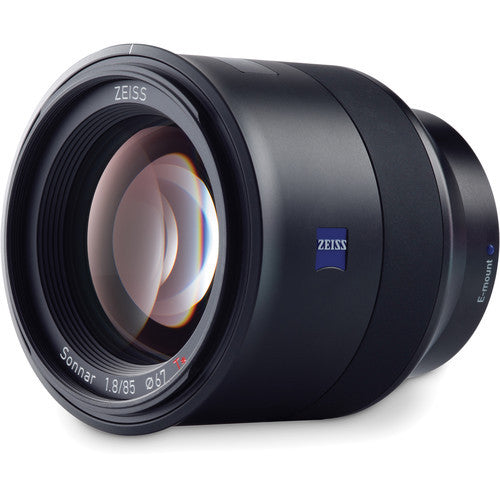
Zeiss Batis 1.8/85 Lens for Sony E-Mount
$ 1,199.00 $ 1,079.00
Zeiss Batis 1.8/85 Lens for Sony E-Mount
Zeiss SKU: 000000-2103-751 | Helix SKU: ZS2103751
Overview
Thanks to a speed of 1:1.8, very low depths of field can be used creatively. The optical image stabilization allows for successful hand-held shooting even in poor light conditions. With a focal length of 85 mm, the lens is the perfect companion for portrait, event, and wedding photography.
The ZEISS Batis autofocus lenses were developed especially for mirrorless full-frame system cameras by Sony. The lenses are fully compatible with all E-mount cameras and offer protection against dust and splashing water in addition to fast and easy autofocus. For creative work, the distance and depth of field can be read from the innovative OLED display. With the completely new lens design, the high-speed ZEISS Batis family offers perfect imaging performance.
A lens design with relatively few glass-to-air surfaces, invented by Dr. Ludwig Bertele at ZEISS in 1930 to provide the fastest lenses of that day for 35 mm photography offering speeds up to f/1.5 and well controlled veiling glare. This is where the name comes from, containig the German word for sun, ’Sonne’, the symbol of utmost brightness.
The design of the autofocus system requires an extremely accurate shifting of particular lens groups. The focusing system of ZEISS lenses is designed to ensure a robust and smooth-running autofocus mechanism with the best imaging performance.
The powerful lens for the mirrorless full-frame system of Sony fulfills the highest requirements. Despite its compact design, the image meets the expectations of professional photographers
Optical image stabilization gives you clear, steady images in poor light conditions. Combined with the camera's own OIS, it provides you the benefits of both systems. In addition, this feature also allows for perfect images without digital noise, as the OIS values do not have to be increased to compensate for poor light conditions.
Thanks to features that are designed to keep out dust and spray water, the lens is perfectly suited for critical outdoor conditions. It is also designed for many years of intensive use.
For the first time, you can accurately read the focus distance and depth of field simply and intuitively on the OLED display on the lens. Especially in poor light conditions – excellent readability is always guaranteed.
Specifications
| Performance | Focal length | 85 mm |
| Aperture range | f/1.8 – f/22 | |
| Camera mount | Sony E-Mount* | |
| Format compatibility | Full Frame | |
| Focusing range | 0,80 m (2.6 ft) – ∞ | |
| Free working distance | 0,71 m (2.3 ft) – ∞ | |
| Angular field** (diag. | horiz. | vert.) | 29° / 24° / 16° | |
| Diameter of image field | 43 mm (1.69") | |
| Coverage at close range (MOD)** | 189 x 283 mm (7.4 x 11.1") | |
| Image ratio at minimum object distance | 1:7.9 | |
| Lens elements | groups | 11 / 8 | |
| Flange focal distance | 18 mm (0.71") | |
| Entrance pupil position (front of image plane) | 18 mm (0.72") | |
| Features | Autofocus | + |
| Image Stabilization | + | |
| Physical | Filter thread | M67 x 0.75 |
| Rotation angle of focusing ring | Focusing not mechanically coupled | |
| Diameter max. | 92 mm (3.6") | |
| Diameter of focusing ring | 78 mm (3.1") | |
| Length (with lens caps) | 105 mm (4.1") | |
| Length (without lens caps) | 92 mm (3.6") | |
| Weight | 452 g (1.0 lbs) |

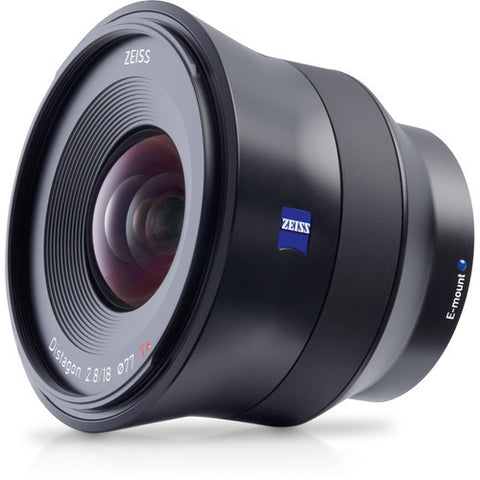
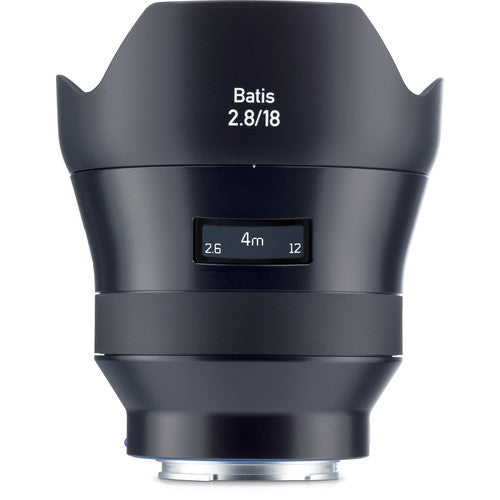
Zeiss Batis 18mm f2.8 Lens for Sony E-Mount
$ 1,499.00 $ 1,349.00
Zeiss Batis 18mm f2.8 Lens for Sony E-Mount
Zeiss SKU: 000000-2136-691 | Helix SKU: ZS2136691
Overview
Very large field angle and fast autofocus – combined with protection against dust and spray water for reliable photography in all weathers: this is the ideal full-frame lens for landscape, astro and architectural photography.
The very large field angle of this super wide-angle lens is perfect for creative shots with unusual perspectives. Consistently excellent image quality right into the corners makes the lens perfect for the challenges of, for example, landscape, astro and architectural photography.
The ZEISS Batis autofocus lenses were specially developed for mirrorless full-frame system cameras from Sony. The lenses are fully compatible with all E-mount cameras and offer not only fast, quiet autofocus, but also protection against dust and spray water. For creative photography, the innovative OLED display shows the distance and depth of field to ensure that the focusing range can always be perfectly set. The result: images that will amaze you. The completely new design of the high-speed ZEISS Batis family offers perfect image quality.
The design of the autofocus system requires an extremely accurate shifting of particular lens groups. The focusing system of ZEISS lenses is designed to ensure a robust and smooth-running autofocus mechanism with the best imaging performance.
The powerful lens for the mirrorless full-frame system of Sony fulfills the highest requirements. Despite its compact design, the image meets the expectations of professional photographers.
Richly saturated and vivid colours are a must in the creation of lasting impressions. However, stray light within an optical system leads to a lightening of the image that is particularly noticeable in the shadows. This reduces image contrast, with the result that exposures lack contrast and appear faded. To avoid this, ZEISS combines various specially developed technologies to reduce the undesirable effects of stray light.
Thanks to features that are designed to keep out dust and spray water, the lens is perfectly suited for critical outdoor conditions. It is also designed for many years of intensive use.
For the first time, you can accurately read the focus distance and depth of field simply and intuitively on the OLED display on the lens. Especially in poor light conditions – excellent readability is always guaranteed.
Originally developed for SLR cameras requiring a long back focal distance for short focal lengths because of the mirror box (the distance between the back lens element and the film plane must be considerably longer than the focal length), the Distagon lenses (retrofocus design) are also ideal for mirrorless system cameras thanks to their optimized ray path. Even with longer focal lengths, the high-performance Distagon optical design enables consistently good correction all the way to the corners of the image and very low field curvature.
Specifications
| Performance | Focal length | 18 mm |
| Aperture range | f/2.8 – f/22 | |
| Camera mount | Sony E-Mount* | |
| Format compatibility | Full Frame | |
| Focusing range | 0,25 m (9.8") – ∞ | |
| Free working distance | 0,17 m (6.7") – ∞ | |
| Angular field** (diag. | horiz. | vert.) | 99° / 90° / 67° | |
| Diameter of image field | 43 mm (1.69") | |
| Coverage at close range (MOD)** | 227 x 340 mm (8.9 x 13.4") | |
| Image ratio at minimum object distance | 1 : 9.5 | |
| Lens elements | groups | 11 / 10 | |
| Flange focal distance | 18 mm (0.71") | |
| Entrance pupil position (front of image plane) | 73 mm (2.9") | |
| Features | Autofocus | + |
| Image Stabilization | – | |
| Physical | Filter thread | M77 x 0.75 |
| Rotation angle of focusing ring | Focusing not mechanically coupled | |
| Diameter max. | 100 mm (3.9") | |
| Diameter of focusing ring | 78 mm (3.1") | |
| Length (with lens caps) | 95 mm (3.7") | |
| Length (without lens caps) | 80 mm (3.1") | |
| Weight | 330 g (0.74 lbs) |

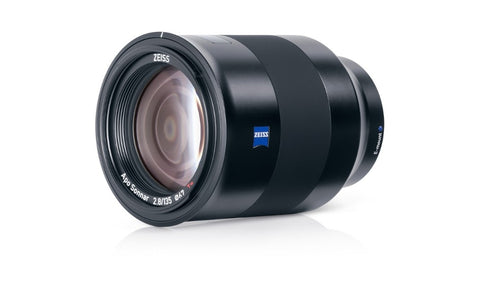
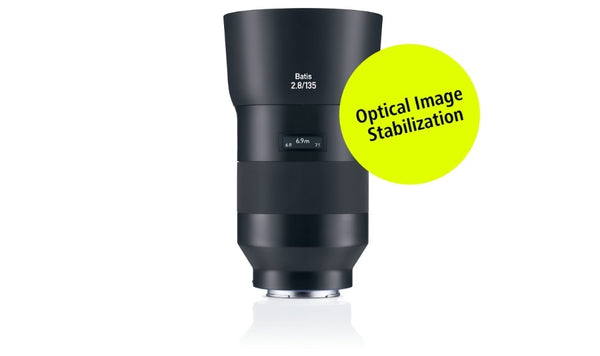
ZEISS Batis 2.8/135 - Sony E-Mount
$ 1,699.00 $ 1,529.00
ZEISS Batis 2.8/135 Lens - Sony E-Mount
Zeiss SKU: 2136-695 | Helix SKU: ZS2136695
Overview
Long focal length, fast autofocus, optical image stabilization. Thanks to the outstanding correction of all chromatic aberrations, the ZEISS Batis 2.8/135 is a high-performance telephoto lens with an Apo Sonnar design. The lens is the optimum solution for medium-distance portrait photography.
The advanced correction of the Apo Sonnar lens design ensures extremely realistic portrayal of your subject. To avoid shaking, an optical image stabilizer has also been integrated in the design. The fast and precise autofocus is your guarantee of sharply defined images - even in difficult light. The shallow depth of field at maximum aperture allows the creative combination of focus and blur, allowing you to direct the viewer's attention to the main subject of your photo.
The ZEISS Batis autofocus lenses were specially developed for mirrorless, full-frame system cameras from Sony. The lenses are fully compatible with all E-mount cameras and offer protection against dust and weather in addition to fast and quiet autofocus. For creative photography, the innovative OLED display shows the distance and depth of field to ensure that the focusing range can always be perfectly set. The result: images that will amaze you. The completely new design of the high-speed ZEISS Batis family offers perfect image quality.
A lens with relatively few glass-air surfaces, it was developed by Dr. Ludwig Bertele at ZEISS in 1930. At the time it was one of the fastest high-speed lenses for 35 mm photography, with apertures as large as 1:1.5 and high contrast thanks to effective stray light reduction. Its high speed and high contrast helped give the lens its name, which is derived from the word “sun,” the symbol of maximum brightness. You continue to find the aforementioned benefits with modern lenses in the normal and telephoto ranges whose optical design is based on this basic type.
Specifications
| Performance | Focal length | 135 mm |
| Aperture range | f/2.8 – f/22 | |
| Camera mount | Sony E-Mount* | |
| Format compatibility | Full Frame | |
| Focusing range | 0,87 m (2.9 ft) – ∞ | |
| Free working distance | 0,74 m (2.4 ft) – ∞ | |
| Angular field** (diag. | horiz. | vert.) | 18° / 15° / 10° | |
| Diameter of image field | 43 mm (1.69") | |
| Coverage at close range (MOD)** | 125 x 185 mm (4.9 x 7.3") | |
| Image ratio at minimum object distance | 1:5.3 | |
| Lens elements | groups | 14 / 11 | |
| Flange focal distance | 18 mm (0.71") | |
| Entrance pupil position (front of image plane) | ||
| Features | Autofocus | + |
| Image Stabilization | + | |
| Physical | Filter thread | M67 x 0.75 |
| Rotation angle of focusing ring | Focusing not mechanically coupled | |
| Diameter max. | 98 mm (3.9") | |
| Diameter of focusing ring | 81 mm (3.2") | |
| Length (with lens caps) | 133 mm (5.2") | |
| Length (without lens caps) | 120 mm (4.7") | |
| Weight | 614 g (1.4 lbs) |

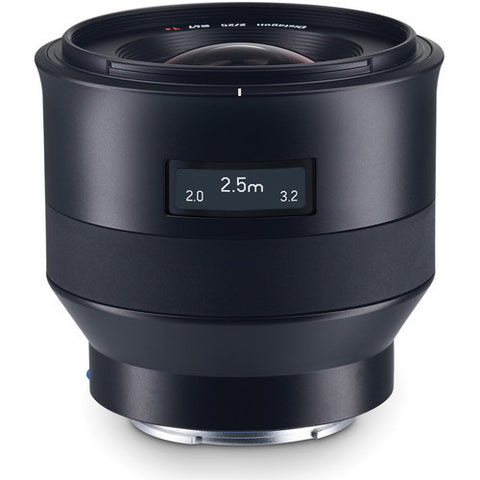
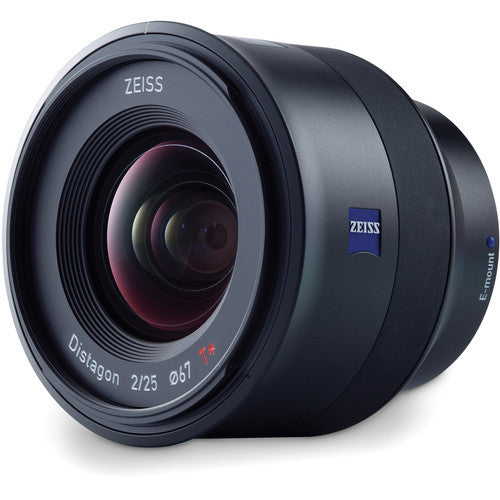
Zeiss Batis 2/25 Lens for Sony E-Mount
$ 1,299.00 $ 1,169.00
Zeiss Batis 2/25 Lens for Sony E-Mount
Zeiss SKU: 000000-2103-750 | Helix SKU: ZS2103750
Overview
Short close-focusing distance, high speed, fast autofocus, and a wide field angle for the full frame: the professional lens for exceptional perspectives in landscape, architecture, street photography and photojournalism.
The very close focusing distance of the 25 mm wide-angle lens supports the creative implementation of exceptional perspectives. An extremely uniform image quality is ensured right into the corners of the image. The lens is the perfect companion for shooting landscapes, architecture, street scenes and photojournalism.
The ZEISS Batis autofocus lenses were specially developed for mirrorless full-frame system cameras from Sony. The lenses are fully compatible with all E-mount cameras and offer not only fast, quiet autofocus, but also protection against dust and spray water. For creative photography, the innovative OLED display shows the distance and depth of field to ensure that the focusing range can always be perfectly set. The result: images that will amaze you. The completely new design of the high-speed ZEISS Batis family offers perfect image quality.
The design of the autofocus system requires an extremely accurate shifting of particular lens groups. The focusing system of ZEISS lenses is designed to ensure a robust and smooth-running autofocus mechanism with the best imaging performance.
The powerful lens for the mirrorless full-frame system of Sony fulfills the highest requirements. Despite its compact design, the image meets the expectations of professional photographers.
Richly saturated and vivid colours are a must in the creation of lasting impressions. However, stray light within an optical system leads to a lightening of the image that is particularly noticeable in the shadows. This reduces image contrast, with the result that exposures lack contrast and appear faded. To avoid this, ZEISS combines various specially developed technologies to reduce the undesirable effects of stray light.
Thanks to features that are designed to keep out dust and spray water, the lens is perfectly suited for critical outdoor conditions. It is also designed for many years of intensive use.
For the first time, you can accurately read the focus distance and depth of field simply and intuitively on the OLED display on the lens. Especially in poor light conditions – excellent readability is always guaranteed.
Originally developed for SLR cameras requiring a long back focal distance for short focal lengths because of the mirror box (the distance between the back lens element and the film plane must be considerably longer than the focal length), the Distagon lenses (retrofocus design) are also ideal for mirrorless system cameras thanks to their optimized ray path. Even with longer focal lengths, the high-performance Distagon optical design enables consistently good correction all the way to the corners of the image and very low field curvature.
Specifications
| Performance | Focal length | 25 mm |
| Aperture range | f/2 – f/22 | |
| Camera mount | Sony E-Mount* | |
| Format compatibility | Full Frame | |
| Focusing range | 0,2 m (7.9") – ∞ | |
| Free working distance | 0,13 m (5.1") – ∞ | |
| Angular field** (diag. | horiz. | vert.) | 82° / 72° / 51° | |
| Diameter of image field | 43 mm (1.69") | |
| Coverage at close range (MOD)** | 124 x 187 mm (4.9 x 7.4") | |
| Image ratio at minimum object distance | 1:5.2 | |
| Lens elements | groups | 10 / 8 | |
| Flange focal distance | 18 mm (0.71") | |
| Entrance pupil position (front of image plane) | 70 mm (2.7") | |
| Features | Autofocus | + |
| Image Stabilization | – | |
| Physical | Filter thread | M67 x 0.75 |
| Rotation angle of focusing ring | Focusing not mechanically coupled | |
| Diameter max. | 81 mm (3.2") | |
| Diameter of focusing ring | 78 mm (3.1") | |
| Length (with lens caps) | 92 mm (3.6") | |
| Length (without lens caps) | 78 mm (3.1") | |
| Weight | 335 g (0.74 lbs) |

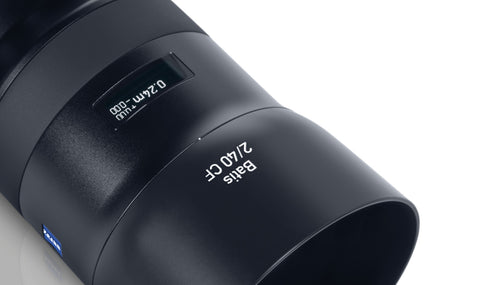

ZEISS Batis 2/40 CF Lens - Sony E-Mount
$ 1,299.00 $ 1,169.00
ZEISS Batis 2/40 CF Lens - Sony E-Mount
ZEISS SKU: 2239-137 | Helix SKU: ZS2239137
Overview
Lightweight wide-angle lens, fast autofocus, close focusing distance: with a 40-millimeter fixed focal length, this lens is excellent for the applications of a standard focal length as well as for typical shooting situations with lightweight wide-angle lenses. An all purpose lens that offers outstanding imaging quality, making it ideal for close-ups.
Thanks to its close focusing distance of just 24 centimeters (9.4 inches), combined with its moderate wide-angle imaging the CloseFocus lens (CF) is excellent for a host of different applications. Thanks to its high micro contrast and initial aperture of f/2, it can perfectly depict individual objects. The ZEISS Batis 2/40 CF on the camera ensures you’re always ready for the important moments – no matter what comes your way. And if you only want to carry one lens with you, this is the best one for your discerning photographer’s eye.
The ZEISS Batis autofocus lenses were specially developed for mirrorless, full-frame sensor cameras from Sony. They have been adapted to work with the camera to form a compact, lightweight system that doesn’t compromise on performance. The lenses are fully compatible with all E-mount cameras and offer not only fast, quiet autofocus, but also protection against dust and weather. For creative photography, the innovative OLED display shows the distance and depth of field to ensure the focusing range can always be perfectly set. The high-speed fixed focal lengths of the ZEISS Batis family offer flawless imaging thanks to their completely revamped optical design. The legendary ZEISS T* anti-reflective coating, combined with more than 125 years of experience in lens development and the latest technologies, ensure that every moment captured with a ZEISS Batis lens provides that exceptional ZEISS look.

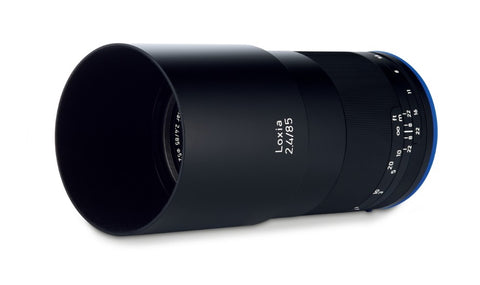
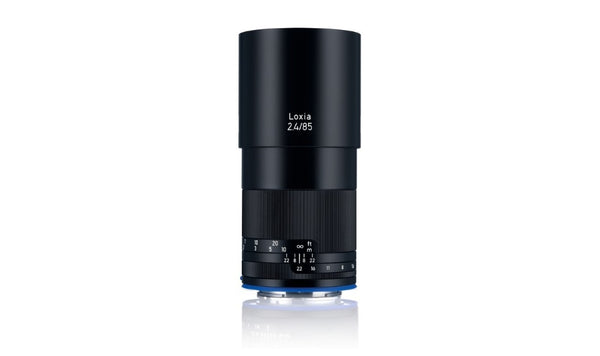
ZEISS Loxia 2.4/85 Lens - Sony E-Mount
$ 1,399.00
ZEISS Loxia 2.4/85 Lens - Sony E-Mount
Zeiss SKU: 2162-636 | Helix SKU: ZS2162636
Overview
Portable, inconspicuous, powerful – fitting ways to describe the ZEISS Loxia 2.4/85 telephoto lens. The completely reworked optical design has been specially developed using seven lens elements for the high-resolution, full-frame sensors of the mirrorless Sony α series. The Loxia 2.4/85 supplements the focal lengths of the ZEISS Loxia product family in the short telephoto lens segment.
Despite its compactness the handy ZEISS Loxia® 2.4/85, a moderate telephoto lens offers outstanding image performance – across the entire image field of a full-frame sensor. Be it for a portrait or a street or landscape shot, this inconspicuous lens is great for helping you master these photographic disciplines.
ZEISS Loxia lenses were specifically designed for Sony α7 cameras. This means that they can make the most of the mirrorless, full frame system, while giving you all the creative possibilities of ‚classic’ photography with manual focus at the same time.
And that’s not all: ZEISS Loxia lenses also provide everything you need to shoot high quality video, such as the unique DeClick feature for smooth adjustment of the aperture, for example.



Zeiss Loxia 2.8/21 - Sony E-Mount
$ 1,499.00
Zeiss Loxia 2.8/21 - Sony E-Mount
Zeiss SKU: 000000-2131-999 | Helix SKU: ZS2131999
Overview
Compact, wide-angle and powerful – these are the properties that make the super wide-angle Loxia 2.8/21 so special. The optical design has been specially developed for high-resolution, full-frame sensors of the mirrorless Sony α series. A system expansion through the new ZEISS Loxia – in a focal length range that has a long tradition at ZEISS.
Despite its compactness, the super wide-angle ZEISS Loxia® 2.8/21 offers outstanding image performance – across the entire image field of a full-frame sensor. Whether architecture, landscape or also three-dimensional subjects in close-up against a spacious background – this focal length with its large image angle is an excellent addition to the Loxia lens family. It is an absolute must for wide-angle fans who want to capture even the tiniest details of a special moment in a photo or on film.
ZEISS Loxia lenses were specifically designed for Sony α7 cameras. This means that they can make the most of the mirrorless, full frame system, while giving you all the creative possibilities of ‘classic’ photography with manual focus at the same time.
And that’s not all: ZEISS Loxia lenses also provide everything you need to shoot high quality video, such as the unique DeClick feature for smooth adjustment of the aperture, for example.
DeClick feature
One completely new feature of the Loxia lens is that you can ‘declick’ the aperture’s locking mechanism using a tool (supplied) and an adjustment screw on the bayonet surface. This means that for video applications, you can smoothly eliminate any unwanted differences in brightness as you pan the camera. This feature can also be used with other video systems whose size makes them suitable for adaption.
Precise manual focus
Manually focusing a lens means controlling the image result from your fingertips. A good ergonomic design makes all the difference. ZEISS lenses stand out with their large rotation angle which enables precise focusing. Changes are immediately visible in the viewfinder. The high-quality focusing mechanism moves smoothly without play, thus also supporting the intuitive interaction with the focal plane. The precise engraving in meter and feet, and the depth of focus scale provide additional support for manually focusing.
Virtually distortion-free optics
Dramatic perspectives and a view from extraordinary image angles – ZEISS lenses open up new composition possibilities. Distortion would disrupt the composition because straight lines, whose image does not go through the image center, would be reproduced with a curved shape. This annoying effect is accordingly and largely compensated through elaborate optical designs at all focal lengths.
High-grade full-metal casing
Tangible quality that holds its value is what qualifies ZEISS lenses for decades of hard use. A precision-engineered full-metal casing, grippy focus and aperture rings made of metal, and a tough front bayonet and filter screw guarantee stunning photographic results. A special sealing ring on the bayonet also protects the interface between the camera and the lens.
Immensely compatible
The ZEISS Loxia lenses are suitable for use with the mirrorless Sony Alpha cameras with E-mount and were optimized for sensors up to full 35 mm format (24 x 36 mm). With the ZEISS Loxia lenses, the aperture is controlled manually. This allowed the integration of the so-called DeClick feature of the mechanical aperture ring. The cameras feature the corresponding automatic exposure control (A) and manual exposure control (M).
Lens Design
ZEISS Loxia 2.8/21
Specifications
| Performance | Focal length | 21 mm |
| Aperture range | f/2.8 – f/22 | |
| Camera mount | Sony E-Mount* | |
| Format compatibility | Full Frame | |
| Focusing range | 0,25 m (9.84") – ∞ | |
| Free working distance | 0,16 m (6.30") – ∞ | |
| Angular field** (diag. | horiz. | vert.) | 91° / 81° / 59° | |
| Diameter of image field | 43 mm (1.69") | |
| Coverage at close range (MOD)** | 281 x 187 mm (11.06 x 7.36") | |
| Image ratio at minimum object distance | 1 : 7.81 | |
| Lens elements | groups | 11 / 9 | |
| Flange focal distance | 18 mm (0.71") | |
| Entrance pupil position (front of image plane) | 67 mm (2.63") | |
| Features | Autofocus | – |
| Image Stabilization | – | |
| Physical | Filter thread | M52 x 0.75 |
| Rotation angle of focusing ring | 90° | |
| Diameter max. | 62 mm (2.44") | |
| Diameter of focusing ring | 62 mm (2.44") | |
| Length (with lens caps) | 85 mm (3.35") | |
| Length (without lens caps) | 72 mm (2.83") | |
| Weight | 394 g (0.87 lbs) |

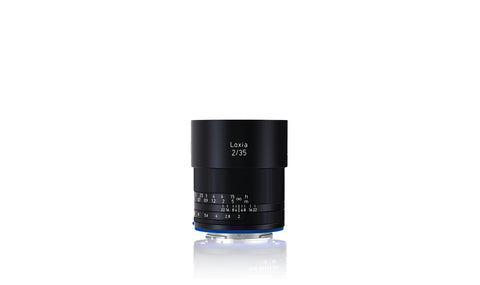
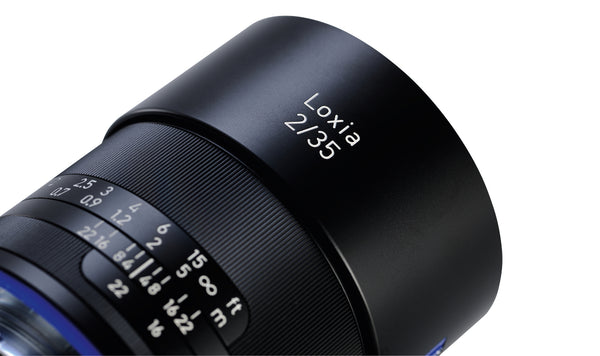
Zeiss Loxia 2/35 Lens for Sony E-Mount
$ 1,299.00
Zeiss Loxia 2/35 Lens for Sony E-Mount
Zeiss SKU: 000000-2103-749 | Helix SKU: ZS2103749
Overview
Light, unassuming and reserved. The moderate wide angle and the creative possibilities of manual focus make the ZEISS Loxia 2/35 a perfect storyteller.
The ZEISS Loxia® 2/35 offers an extended field of view. This makes it the first choice for showing a subject in their environment or establishing connections between people. Like in reportage or street photography, for example. That’s what makes it the most important focal length for the genre in compact 35mm cameras. At the same time, the small size and weight of this camera system allows for a great deal of independence and discretion when it comes to photographing your subjects. And precise, manual focus gives you all the creative possibilities you need to tell the story in your own personal way.
ZEISS Loxia lenses were specifically designed for Sony α7 cameras. This means that they can make the most of the mirrorless, full frame system, while giving you all the creative possibilities of ‘classic’ photography with manual focus at the same time.
And that’s not all: ZEISS Loxia lenses also provide everything you need to shoot high quality video, such as the unique DeClick feature for smooth adjustment of the aperture, for example.
One completely new feature of the Loxia lens is that you can ‘declick’ the aperture’s locking mechanism using a tool (supplied) and an adjustment screw on the bayonet surface. This means that for video applications, you can smoothly eliminate any unwanted differences in brightness as you pan the camera. This feature can also be used with other video systems whose size makes them suitable for adaption.
Manually focusing a lens means controlling the image result from your fingertips. A good ergonomic design makes all the difference. ZEISS lenses stand out with their large rotation angle which enables precise focusing. Changes are immediately visible in the viewfinder. The high-quality focusing mechanism moves smoothly without play, thus also supporting the intuitive interaction with the focal plane. The precise engraving in meter and feet, and the depth of focus scale provide additional support for manually focusing.
Dramatic perspectives and a view from extraordinary image angles – ZEISS lenses open up new composition possibilities. Distortion would disrupt the composition because straight lines, whose image does not go through the image center, would be reproduced with a curved shape. This annoying effect is accordingly and largely compensated through elaborate optical designs at all focal lengths.
Tangible quality that holds its value is what qualifies ZEISS lenses for decades of hard use. A precision-engineered full-metal casing, grippy focus and aperture rings made of metal, and a tough front bayonet and filter screw guarantee stunning photographic results. A special sealing ring on the bayonet also protects the interface between the camera and the lens.
The ZEISS Loxia lenses are suitable for use with the mirrorless Sony Alpha cameras with E-mount and were optimized for sensors up to full 35 mm format (24 x 36 mm). With the ZEISS Loxia lenses, the aperture is controlled manually. This allowed the integration of the so-called DeClick feature of the mechanical aperture ring. The cameras feature the corresponding automatic exposure control (A) and manual exposure control (M).
A lens with such a large field angle that it can capture as much of the photographer's surroundings as possible in a single shot – this is the origin of the name Biogon®. The largely symmetrical Biogon optical design enables the use of very compact, moderate to extremely wide-angle lenses, including with rangefinder and mirrorless system cameras. The lenses feature exceptionally good distortion correction, chromatic properties and image field flattening.
Specifcations
| Performance | Focal length | 35 mm |
| Aperture range | f/2.0 – f/22 | |
| Camera mount | Sony E-Mount* | |
| Format compatibility | Full Frame | |
| Focusing range | 0,30 m (11.81") - ∞ | |
| Free working distance | 0,23 m (9.06") - ∞ | |
| Angular field** (diag. | horiz. | vert.) | 63° / 54° / 38° | |
| Diameter of image field | 43 mm (1.69") | |
| Coverage at close range (MOD)** | 210 x 139 mm (8.28 x 5.49") | |
| Image ratio at minimum object distance | 1 : 5.8 | |
| Lens elements | groups | 9 / 6 | |
| Flange focal distance | 18 mm (0.71") | |
| Entrance pupil position (front of image plane) | 52 mm (2.03") | |
| Features | Autofocus | – |
| Image Stabilization | – | |
| Physical | Filter thread | M52 x 0.75 |
| Rotation angle of focusing ring | 180° | |
| Diameter max. | 62 mm (2.44") | |
| Diameter of focusing ring | 62 mm (2.44") | |
| Length (with lens caps) | 66 mm (2.60") | |
| Length (without lens caps) | 59 mm (2.33") | |
| Weight | 340 g (0.75 lbs) |

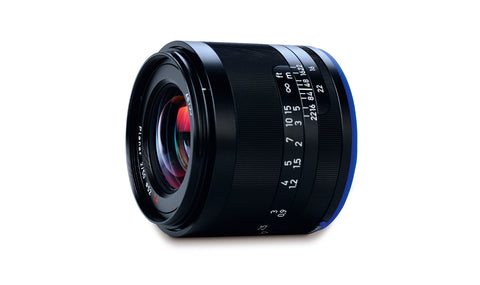
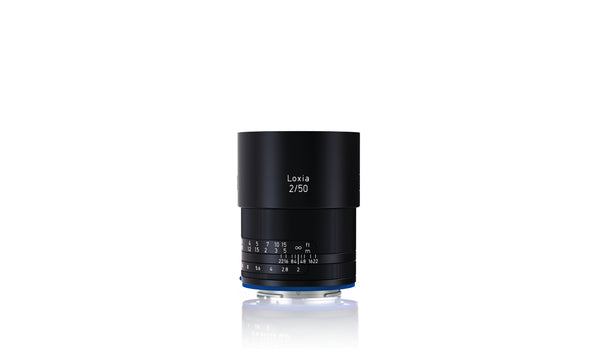
Zeiss Loxia 2/50 Lens for Sony E-Mount
$ 949.00
Zeiss Loxia 2/50 Lens for Sony E-Mount
Zeiss SKU: 000000-2103-748 | Helix SKU: ZS2103748
Overview
Our compact standard lens for full frame Sony α7 cameras. Revel in the exceptional feel of precise manual focus, giving you unparalleled creative freedom at your fingertips.
A 50mm lens was legendary photographer Cartier Bresson’s favourite. The reason is simple: this focal length provides the equivalent field of view of the human eye on a 35mm camera, which makes for a very natural perspective. Compact, light and extremely flexible, the ZEISS Loxia® 2/50 shines in the most varied of applications. Regardless of whether it’s for street photography, landscapes, portraits or spontaneous discoveries, the ZEISS Loxia 2/50 is the ideal companion for photographic and filmic exploration.
ZEISS Loxia lenses were specifically designed for Sony α7 cameras. This means that they can make the most of the mirrorless, full frame system, while giving you all the creative possibilities of ‚classic’ photography with manual focus at the same time.
And that’s not all: ZEISS Loxia lenses also provide everything you need to shoot high quality video, such as the unique DeClick feature for smooth adjustment of the aperture, for example.
One completely new feature of the Loxia lens is that you can ‘declick’ the aperture’s locking mechanism using a tool (supplied) and an adjustment screw on the bayonet surface. This means that for video applications, you can smoothly eliminate any unwanted differences in brightness as you pan the camera. This feature can also be used with other video systems whose size makes them suitable for adaption.
Manually focusing a lens means controlling the image result from your fingertips. A good ergonomic design makes all the difference. ZEISS lenses stand out with their large rotation angle which enables precise focusing. Changes are immediately visible in the viewfinder. The high-quality focusing mechanism moves smoothly without play, thus also supporting the intuitive interaction with the focal plane. The precise engraving in meter and feet, and the depth of focus scale provide additional support for manually focusing.
Dramatic perspectives and a view from extraordinary image angles – ZEISS lenses open up new composition possibilities. Distortion would disrupt the composition because straight lines, whose image does not go through the image center, would be reproduced with a curved shape. This annoying effect is accordingly and largely compensated through elaborate optical designs at all focal lengths.
Tangible quality that holds its value is what qualifies ZEISS lenses for decades of hard use. A precision-engineered full-metal casing, grippy focus and aperture rings made of metal, and a tough front bayonet and filter screw guarantee stunning photographic results. A special sealing ring on the bayonet also protects the interface between the camera and the lens.
The ZEISS Loxia lenses are suitable for use with the mirrorless Sony Alpha cameras with E-mount and were optimized for sensors up to full 35 mm format (24 x 36 mm). With the ZEISS Loxia lenses, the aperture is controlled manually. This allowed the integration of the so-called DeClick feature of the mechanical aperture ring. The cameras feature the corresponding automatic exposure control (A) and manual exposure control (M).
The Planar lens design is the most successful – and most frequently copied – camera lens design of all time. Modifications to the tried-and-tested six-lens basic type ensure that it achieves the high imaging quality required by modern sensors. Lenses with a Planar optical design enable consistent performance across a large range of image scales – the key requirement for universal macro-lenses.
Specifications
| Performance | Focal length | 50 mm |
| Aperture range | f/2.0 – f/22 | |
| Camera mount | Sony E-Mount* | |
| Format compatibility | Full Frame | |
| Focusing range | 0,45 m (17.72") - ∞ | |
| Free working distance | 0,37 m (14.57") - ∞ | |
| Angular field** (diag. | horiz. | vert.) | 47° / 39° / 27° | |
| Diameter of image field | 43 mm (1.69") | |
| Coverage at close range (MOD)** | 255 x 168 mm (10.04 x 6.63") | |
| Image ratio at minimum object distance | 1 : 6.9 | |
| Lens elements | groups | 6 / 4 | |
| Flange focal distance | 18 mm (0.71") | |
| Entrance pupil position (front of image plane) | 49 mm (1.91") | |
| Features | Autofocus | – |
| Image Stabilization | – | |
| Physical | Filter thread | M52 x 0.75 |
| Rotation angle of focusing ring | 180° | |
| Diameter max. | 62 mm (2.44") | |
| Diameter of focusing ring | 62 mm (2.44") | |
| Length (with lens caps) | 66 mm (2.60") | |
| Length (without lens caps) | 59 mm (2.33") | |
| Weight | 320 g (0.71lbs) |

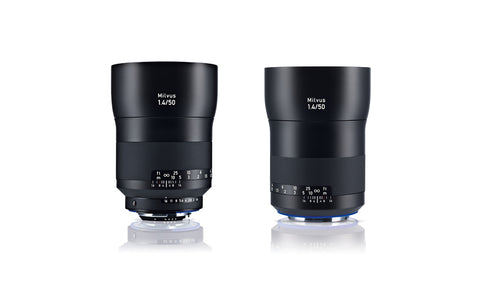
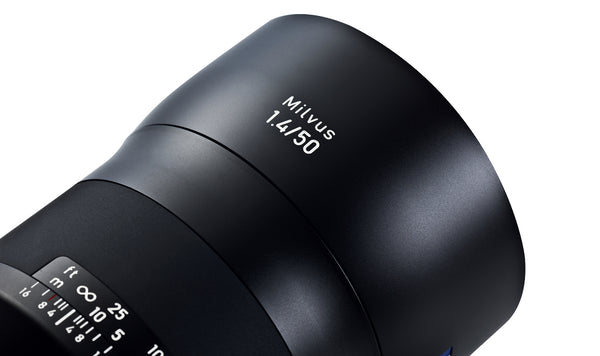
Zeiss Milvus 1.4/50 ZE - Canon Mount
$ 1,274.00
Zeiss Milvus 1.4/50 ZE - Canon Mount
Zeiss SKU: 000000-2096-557 | Helix SKU: ZS2096557
Overview
This focal length is the ideal tool for imaging real-life situations – whether it is the hustle and bustle of a busy road, the intimacy of a portrait or the wonders of nature. It is always in quest of those real and unadulterated perspectives. The ZEISS Milvus 1.4/50 is a versatile focal length that meets even the highest standards.
The redesigned ZEISS Milvus 1.4/50 corresponds to the perspective of the human eye on full-frame cameras and can therefore be used for many different purposes. In other words, it is a lens of many talents. Realistic imaging of three-dimensional objects is guaranteed at all times. Despite its high speed, the advanced ZEISS Distagon optical design ensures outstanding imagery across the entire image field – even at full aperture.
All lenses features a T*® antireflective coating from ZEISS. Outstanding stray light reduction is achieved by combining a number of optimally matched measures. In addition to the ZEISS T* coating, all lens edges are provided with a special pitch-black lacquer in a complex manual process. Light traps in mechanical components and specially designed surfaces are integrated to prevent the occurrence of reflections. Each focal length has its own individual optical design with the use of special types of glass displaying anomalous partial dispersion. This reduces the occurrence of color fringes at high-contrast edges of subjects to an absolute minimum.
The excellent image performance of the ZEISS Milvus Lenses is sharply focused on the requirements of current and future high-performance digital cameras. Thanks to the low level of stray light allowed by the lens design, high-contrast images are also possible with increasing high dynamic ranges of the sensors (HDR). The minimization of coma, astigmatism and spherical aberrations enables constantly high resolution over the entire image field. The optics are designed to ensure full utilization of the performance provided by high-resolution camera systems. Regardless of what the future holds – with the Milvus Lenses from ZEISS you are optimally equipped any time, any place.
Manually focusing a lens means controlling and therefore actively composing an image gently and precisely from your fingertips. Here, a good ergonomic design makes all the difference. ZEISS Milvus Lenses feature a large rotation angle which enables pinpoint focusing. The top-quality focusing mechanism moves smoothly without backlash, optimally supporting the photographer's creative interplay with the focal plane of high-speed fixed focal lengths. Changes are immediately visible in the viewfinder or display. The engraving in meters and feet, and the focus scale provide additional support for manual focusing. The silent, continuous aperture setting (de-click function with ZF.2 mount) and the long focusing range lay optimal conditions for video photography.
An optimized ergonomic design enables fatigue-free photography and reduces camera shake. The all-metal housing makes every adjustment a haptic experience. The dynamic, precise barrel design sets new trends in the world of camera lenses. However, the ZEISS Milvus Lenses will impress you not only due to their visual and haptic excellence, but also thanks to their inner qualities. Special seals for protection against dust and splashes expand the photographer's creative potential by guaranteeing the system's functional reliability even in environmentally difficult situations.
State-of-the-art camera systems and high-resolution digital image sensors are now demanding more and more performance from the lenses. The Floating Elements Design permits constantly high image performance in the focal plane – from the minimum object distance to infinity. This is accomplished by changing the axial distance between individual lens elements or element groups. The adjustment of the element spacing is coupled to the distance setting so that it always results in the right correction. The mechanical design of the ZEISS Milvus Lenses is highly complex and the workmanship must be extremely exact – both specialties of ZEISS.
Originally developed for SLR cameras requiring a long back focal distance for short focal lengths because of the mirror box (the distance between the back lens element and the film plane must be considerably longer than the focal length), the Distagon lenses (retrofocus design) are also ideal for mirrorless system cameras thanks to their optimized ray path. Even with longer focal lengths, the high-performance Distagon optical design enables consistently good correction all the way to the corners of the image and very low field curvature.
Specifications
| Performance | Focal length | 50 mm |
| Aperture range | f/1.4 – f/16 | |
| Camera mount | Canon EF-Mount* (ZE) | Nikon F-Mount* (ZF.2) | |
| Format compatibility | Full Frame | |
| Focusing range | 0,45 m (17.7") - ∞ | |
| Free working distance | 0,34 m (13.4") - ∞ | |
| Angular field** (diag. | horiz. | vert.) | 46° / 39° / 26° | |
| Diameter of image field | 43 mm (1.69") | |
| Coverage at close range (MOD)** | 245 x 162 mm (9.65 x 6.38") | |
| Image ratio at minimum object distance | 1 : 6.7 | |
| Lens elements | groups | 10 / 8 | |
| Flange focal distance | ZE: 44 mm (1.73") | ZF.2: 46 mm (1.83") | |
| Entrance pupil position (front of image plane) | 80 mm (3.16") | |
| Features | Autofocus | – |
| Image Stabilization | – | |
| Physical | Filter thread | M67 x 0.75 |
| Rotation angle of focusing ring | 225° | |
| Diameter max. | ZE: 83 mm (3.25") | ZF.2: 83 mm (3.25") | |
| Diameter of focusing ring | ZE: 80 mm (3.13") | ZF.2: 80 mm (3.13") | |
| Length (with lens caps) | ZE: 109 mm (4.29") | ZF.2: 106 mm (4.19") | |
| Length (without lens caps) | ZE: 98 mm (3.84") | ZF.2: 94 mm (3.70") | |
| Weight | ZE: 922 g (32.52 oz) | ZF.2: 875 g (30.86 oz) |

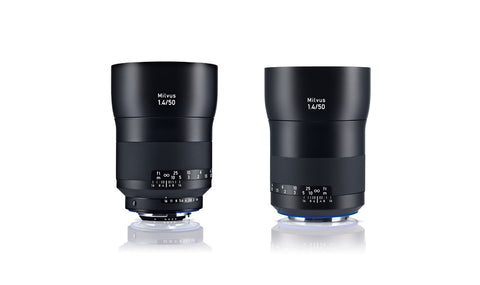
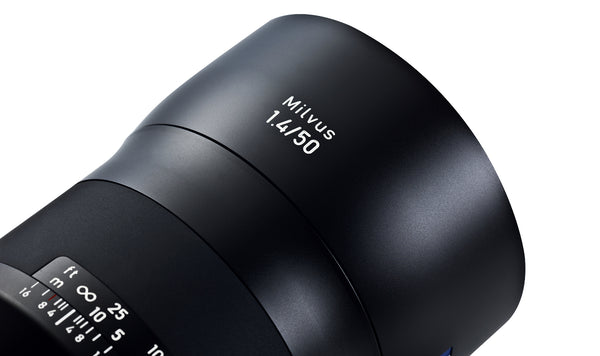
Zeiss Milvus 1.4/50 ZF.2 - Nikon Mount
$ 1,274.00
Zeiss Milvus 1.4/50 ZF.2 - Nikon Mount
Zeiss SKU: 000000-2096-556 | Helix SKU: ZS2096556
Overview
This focal length is the ideal tool for imaging real-life situations – whether it is the hustle and bustle of a busy road, the intimacy of a portrait or the wonders of nature. It is always in quest of those real and unadulterated perspectives. The ZEISS Milvus 1.4/50 is a versatile focal length that meets even the highest standards.
The redesigned ZEISS Milvus 1.4/50 corresponds to the perspective of the human eye on full-frame cameras and can therefore be used for many different purposes. In other words, it is a lens of many talents. Realistic imaging of three-dimensional objects is guaranteed at all times. Despite its high speed, the advanced ZEISS Distagon optical design ensures outstanding imagery across the entire image field – even at full aperture.
All lenses features a T*® antireflective coating from ZEISS. Outstanding stray light reduction is achieved by combining a number of optimally matched measures. In addition to the ZEISS T* coating, all lens edges are provided with a special pitch-black lacquer in a complex manual process. Light traps in mechanical components and specially designed surfaces are integrated to prevent the occurrence of reflections. Each focal length has its own individual optical design with the use of special types of glass displaying anomalous partial dispersion. This reduces the occurrence of color fringes at high-contrast edges of subjects to an absolute minimum.
The excellent image performance of the ZEISS Milvus Lenses is sharply focused on the requirements of current and future high-performance digital cameras. Thanks to the low level of stray light allowed by the lens design, high-contrast images are also possible with increasing high dynamic ranges of the sensors (HDR). The minimization of coma, astigmatism and spherical aberrations enables constantly high resolution over the entire image field. The optics are designed to ensure full utilization of the performance provided by high-resolution camera systems. Regardless of what the future holds – with the Milvus Lenses from ZEISS you are optimally equipped any time, any place.
Manually focusing a lens means controlling and therefore actively composing an image gently and precisely from your fingertips. Here, a good ergonomic design makes all the difference. ZEISS Milvus Lenses feature a large rotation angle which enables pinpoint focusing. The top-quality focusing mechanism moves smoothly without backlash, optimally supporting the photographer's creative interplay with the focal plane of high-speed fixed focal lengths. Changes are immediately visible in the viewfinder or display. The engraving in meters and feet, and the focus scale provide additional support for manual focusing. The silent, continuous aperture setting (de-click function with ZF.2 mount) and the long focusing range lay optimal conditions for video photography.
An optimized ergonomic design enables fatigue-free photography and reduces camera shake. The all-metal housing makes every adjustment a haptic experience. The dynamic, precise barrel design sets new trends in the world of camera lenses. However, the ZEISS Milvus Lenses will impress you not only due to their visual and haptic excellence, but also thanks to their inner qualities. Special seals for protection against dust and splashes expand the photographer's creative potential by guaranteeing the system's functional reliability even in environmentally difficult situations.
State-of-the-art camera systems and high-resolution digital image sensors are now demanding more and more performance from the lenses. The Floating Elements Design permits constantly high image performance in the focal plane – from the minimum object distance to infinity. This is accomplished by changing the axial distance between individual lens elements or element groups. The adjustment of the element spacing is coupled to the distance setting so that it always results in the right correction. The mechanical design of the ZEISS Milvus Lenses is highly complex and the workmanship must be extremely exact – both specialties of ZEISS.
Originally developed for SLR cameras requiring a long back focal distance for short focal lengths because of the mirror box (the distance between the back lens element and the film plane must be considerably longer than the focal length), the Distagon lenses (retrofocus design) are also ideal for mirrorless system cameras thanks to their optimized ray path. Even with longer focal lengths, the high-performance Distagon optical design enables consistently good correction all the way to the corners of the image and very low field curvature.
Specifications
| Performance | Focal length | 50 mm |
| Aperture range | f/1.4 – f/16 | |
| Camera mount | Canon EF-Mount* (ZE) | Nikon F-Mount* (ZF.2) | |
| Format compatibility | Full Frame | |
| Focusing range | 0,45 m (17.7") - ∞ | |
| Free working distance | 0,34 m (13.4") - ∞ | |
| Angular field** (diag. | horiz. | vert.) | 46° / 39° / 26° | |
| Diameter of image field | 43 mm (1.69") | |
| Coverage at close range (MOD)** | 245 x 162 mm (9.65 x 6.38") | |
| Image ratio at minimum object distance | 1 : 6.7 | |
| Lens elements | groups | 10 / 8 | |
| Flange focal distance | ZE: 44 mm (1.73") | ZF.2: 46 mm (1.83") | |
| Entrance pupil position (front of image plane) | 80 mm (3.16") | |
| Features | Autofocus | – |
| Image Stabilization | – | |
| Physical | Filter thread | M67 x 0.75 |
| Rotation angle of focusing ring | 225° | |
| Diameter max. | ZE: 83 mm (3.25") | ZF.2: 83 mm (3.25") | |
| Diameter of focusing ring | ZE: 80 mm (3.13") | ZF.2: 80 mm (3.13") | |
| Length (with lens caps) | ZE: 109 mm (4.29") | ZF.2: 106 mm (4.19") | |
| Length (without lens caps) | ZE: 98 mm (3.84") | ZF.2: 94 mm (3.70") | |
| Weight | ZE: 922 g (32.52 oz) | ZF.2: 875 g (30.86 oz) |

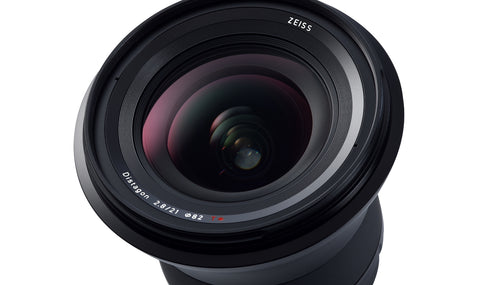
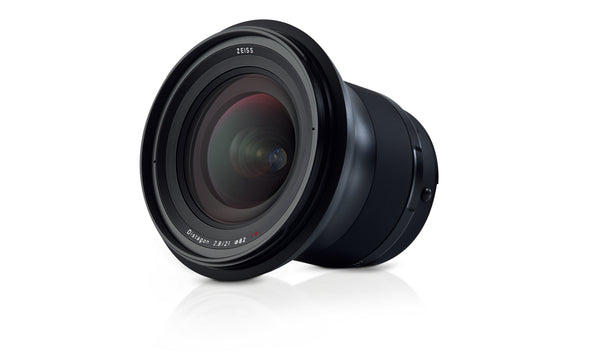
Zeiss Milvus 2.8/21 ZE - Canon Mount
$ 1,918.00
Zeiss Milvus 2.8/21 ZE - Canon Mount
Zeiss SKU: 000000-2096-549 | Helix SKU: ZS2096549
Overview
t's in those situations when the horizon seems absolutely endless that ZEISS Milvus 2.8/21 is in its element. The super wide-angle lenses is ideal for photographing vast, far-stretching landscapes and breathtaking scenery.
The ZEISS Milvus 2.8/21 super wide-angle lens of the type ZEISS Distagon is the best in its class. Thanks to its maximum aperture of f/2.8, the reflection-free and practically distortion-free super wide-angle lens is perfect for spectacular image compositions of great diversity, dramatic contrast and vivid colors. The further optimization of the lens coating reduces ghosting and flare effects in critical light situations.
All lenses features a T*® antireflective coating from ZEISS. Outstanding stray light reduction is achieved by combining a number of optimally matched measures. In addition to the ZEISS T* coating, all lens edges are provided with a special pitch-black lacquer in a complex manual process. Light traps in mechanical components and specially designed surfaces are integrated to prevent the occurrence of reflections. Each focal length has its own individual optical design with the use of special types of glass displaying anomalous partial dispersion. This reduces the occurrence of color fringes at high-contrast edges of subjects to an absolute minimum.
The excellent image performance of the ZEISS Milvus Lenses is sharply focused on the requirements of current and future high-performance digital cameras. Thanks to the low level of stray light allowed by the lens design, high-contrast images are also possible with increasing high dynamic ranges of the sensors (HDR). The minimization of coma, astigmatism and spherical aberrations enables constantly high resolution over the entire image field. The optics are designed to ensure full utilization of the performance provided by high-resolution camera systems. Regardless of what the future holds – with the Milvus Lenses from ZEISS you are optimally equipped any time, any place.
Manually focusing a lens means controlling and therefore actively composing an image gently and precisely from your fingertips. Here, a good ergonomic design makes all the difference. ZEISS Milvus Lenses feature a large rotation angle which enables pinpoint focusing. The top-quality focusing mechanism moves smoothly without backlash, optimally supporting the photographer's creative interplay with the focal plane of high-speed fixed focal lengths. Changes are immediately visible in the viewfinder or display. The engraving in meters and feet, and the focus scale provide additional support for manual focusing. The silent, continuous aperture setting (de-click function with ZF.2 mount) and the long focusing range lay optimal conditions for video photography.
An optimized ergonomic design enables fatigue-free photography and reduces camera shake. The all-metal housing makes every adjustment a haptic experience. The dynamic, precise barrel design sets new trends in the world of camera lenses. However, the ZEISS Milvus Lenses will impress you not only due to their visual and haptic excellence, but also thanks to their inner qualities. Special seals for protection against dust and splashes expand the photographer's creative potential by guaranteeing the system's functional reliability even in environmentally difficult situations.
State-of-the-art camera systems and high-resolution digital image sensors are now demanding more and more performance from the lenses. The Floating Elements Design permits constantly high image performance in the focal plane – from the minimum object distance to infinity. This is accomplished by changing the axial distance between individual lens elements or element groups. The adjustment of the element spacing is coupled to the distance setting so that it always results in the right correction. The mechanical design of the ZEISS Milvus Lenses is highly complex and the workmanship must be extremely exact – both specialties of ZEISS.
Originally developed for SLR cameras requiring a long back focal distance for short focal lengths because of the mirror box (the distance between the back lens element and the film plane must be considerably longer than the focal length), the Distagon lenses (retrofocus design) are also ideal for mirrorless system cameras thanks to their optimized ray path. Even with longer focal lengths, the high-performance Distagon optical design enables consistently good correction all the way to the corners of the image and very low field curvature.
Specifications
| Performance | Focal length | 21 mm |
| Aperture range | f/2.8 – f/22 | |
| Camera mount | Canon EF-Mount* (ZE) | Nikon F-Mount* (ZF.2) | |
| Format compatibility | Full Frame | |
| Focusing range | 0,22 m (8.66") - ∞ | |
| Free working distance | 0,09 m (3.54") - ∞ | |
| Angular field** (diag. | horiz. | vert.) | 90° / 81° / 59° | |
| Diameter of image field | 43 mm (1.69") | |
| Coverage at close range (MOD)** | 120 x 180 mm (4.72 x 7.09") | |
| Image ratio at minimum object distance | 1 : 5 | |
| Lens elements | groups | 16 / 13 | |
| Flange focal distance | ZE: 44 mm (1.73") | ZF.2: 46 mm (1.83") | |
| Entrance pupil position (front of image plane) | 106 mm (4.17") | |
| Features | Autofocus | – |
| Image Stabilization | – | |
| Physical | Filter thread | M82 x 0.75 |
| Rotation angle of focusing ring | 124° | |
| Diameter max. | ZE: 96 mm (3.76") | ZF.2: 95 mm (3.75") | |
| Diameter of focusing ring | ZE: 72 mm (2.85") | ZF.2: 69 mm (2.74") | |
| Length (with lens caps) | ZE: 112 mm (4.40") | ZF.2: 110 mm (4.31") | |
| Length (without lens caps) | ZE: 95 mm (3.74") | ZF.2: 93 mm (3.64") | |
| Weight | ZE: 851 g (30.02 oz) | ZF.2: 735 g (25.93 oz) |

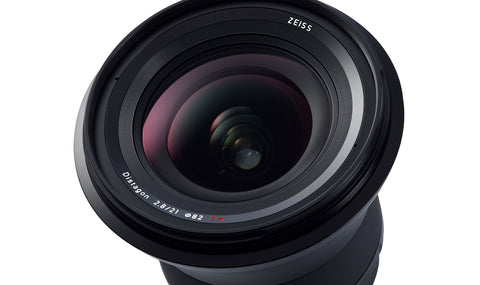
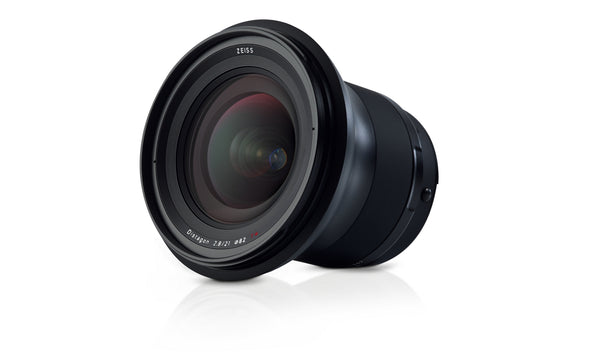
Zeiss Milvus 2.8/21 ZF.2 - Nikon Mount
$ 1,843.00
Zeiss Milvus 2.8/21 ZF.2 - Nikon Mount
Zeiss SKU: 000000-2069-548 | Helix SKU: ZS2096548
Overview
Originally developed for SLR cameras requiring a long back focal distance for short focal lengths because of the mirror box (the distance between the back lens element and the film plane must be considerably longer than the focal length), the Distagon lenses (retrofocus design) are also ideal for mirrorless system cameras thanks to their optimized ray path. Even with longer focal lengths, the high-performance Distagon optical design enables consistently good correction all the way to the corners of the image and very low field curvature.
All lenses features a T*® antireflective coating from ZEISS. Outstanding stray light reduction is achieved by combining a number of optimally matched measures. In addition to the ZEISS T* coating, all lens edges are provided with a special pitch-black lacquer in a complex manual process. Light traps in mechanical components and specially designed surfaces are integrated to prevent the occurrence of reflections. Each focal length has its own individual optical design with the use of special types of glass displaying anomalous partial dispersion. This reduces the occurrence of color fringes at high-contrast edges of subjects to an absolute minimum.
The excellent image performance of the ZEISS Milvus Lenses is sharply focused on the requirements of current and future high-performance digital cameras. Thanks to the low level of stray light allowed by the lens design, high-contrast images are also possible with increasing high dynamic ranges of the sensors (HDR). The minimization of coma, astigmatism and spherical aberrations enables constantly high resolution over the entire image field. The optics are designed to ensure full utilization of the performance provided by high-resolution camera systems. Regardless of what the future holds – with the Milvus Lenses from ZEISS you are optimally equipped any time, any place.
Manually focusing a lens means controlling and therefore actively composing an image gently and precisely from your fingertips. Here, a good ergonomic design makes all the difference. ZEISS Milvus Lenses feature a large rotation angle which enables pinpoint focusing. The top-quality focusing mechanism moves smoothly without backlash, optimally supporting the photographer's creative interplay with the focal plane of high-speed fixed focal lengths. Changes are immediately visible in the viewfinder or display. The engraving in meters and feet, and the focus scale provide additional support for manual focusing. The silent, continuous aperture setting (de-click function with ZF.2 mount) and the long focusing range lay optimal conditions for video photography.
An optimized ergonomic design enables fatigue-free photography and reduces camera shake. The all-metal housing makes every adjustment a haptic experience. The dynamic, precise barrel design sets new trends in the world of camera lenses. However, the ZEISS Milvus Lenses will impress you not only due to their visual and haptic excellence, but also thanks to their inner qualities. Special seals for protection against dust and splashes expand the photographer's creative potential by guaranteeing the system's functional reliability even in environmentally difficult situations.
State-of-the-art camera systems and high-resolution digital image sensors are now demanding more and more performance from the lenses. The Floating Elements Design permits constantly high image performance in the focal plane – from the minimum object distance to infinity. This is accomplished by changing the axial distance between individual lens elements or element groups. The adjustment of the element spacing is coupled to the distance setting so that it always results in the right correction. The mechanical design of the ZEISS Milvus Lenses is highly complex and the workmanship must be extremely exact – both specialties of ZEISS.
Specifications
| Performance | Focal length | 21 mm |
| Aperture range | f/2.8 – f/22 | |
| Camera mount | Canon EF-Mount* (ZE) | Nikon F-Mount* (ZF.2) | |
| Format compatibility | Full Frame | |
| Focusing range | 0,22 m (8.66") - ∞ | |
| Free working distance | 0,09 m (3.54") - ∞ | |
| Angular field** (diag. | horiz. | vert.) | 90° / 81° / 59° | |
| Diameter of image field | 43 mm (1.69") | |
| Coverage at close range (MOD)** | 120 x 180 mm (4.72 x 7.09") | |
| Image ratio at minimum object distance | 1 : 5 | |
| Lens elements | groups | 16 / 13 | |
| Flange focal distance | ZE: 44 mm (1.73") | ZF.2: 46 mm (1.83") | |
| Entrance pupil position (front of image plane) | 106 mm (4.17") | |
| Features | Autofocus | – |
| Image Stabilization | – | |
| Physical | Filter thread | M82 x 0.75 |
| Rotation angle of focusing ring | 124° | |
| Diameter max. | ZE: 96 mm (3.76") | ZF.2: 95 mm (3.75") | |
| Diameter of focusing ring | ZE: 72 mm (2.85") | ZF.2: 69 mm (2.74") | |
| Length (with lens caps) | ZE: 112 mm (4.40") | ZF.2: 110 mm (4.31") | |
| Length (without lens caps) | ZE: 95 mm (3.74") | ZF.2: 93 mm (3.64") | |
| Weight | ZE: 851 g (30.02 oz) | ZF.2: 735 g (25.93 oz) |

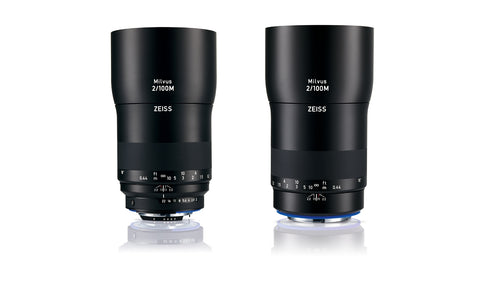
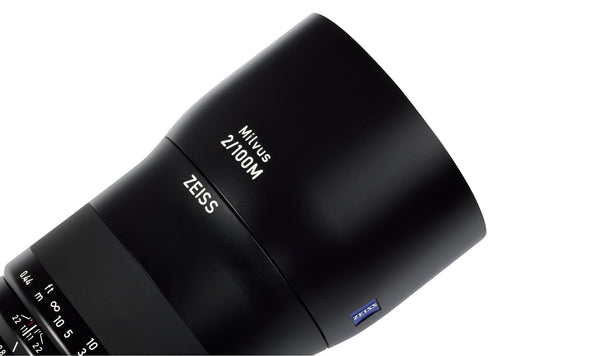
Zeiss Milvus 2/100M ZE - Canon Mount
$ 1,918.00
Zeiss Milvus 2/100M ZE - Canon Mount
Zeiss SKU: 000000-2096-563 | Helix SKU: ZS2096563
Overview
Whether in its role as a high-precision reproduction lens for technical applications or as a traditional, moderate tele-lens for portraits with shallow depth of field, the ZEISS Milvus 2/100M allows you to delve into both worlds.
The ZEISS Milvus 2/100M of the type ZEISS Makro-Planar is currently the fastest 100 mm macro lens on the market and closes the gap between long range and breathtaking close-up shots. This lens bridges distances and allows unique image compositions. This lens is ideal when you need some distance between your camera and your subject, e.g.during a portrait shoot. Its precise mechanical components with a large focus throw permit precise control which is particularly important for macro photography in the close-up range.
All lenses features a T*® antireflective coating from ZEISS. Outstanding stray light reduction is achieved by combining a number of optimally matched measures. In addition to the ZEISS T* coating, all lens edges are provided with a special pitch-black lacquer in a complex manual process. Light traps in mechanical components and specially designed surfaces are integrated to prevent the occurrence of reflections. Each focal length has its own individual optical design with the use of special types of glass displaying anomalous partial dispersion. This reduces the occurrence of color fringes at high-contrast edges of subjects to an absolute minimum.
The excellent image performance of the ZEISS Milvus Lenses is sharply focused on the requirements of current and future high-performance digital cameras. Thanks to the low level of stray light allowed by the lens design, high-contrast images are also possible with increasing high dynamic ranges of the sensors (HDR). The minimization of coma, astigmatism and spherical aberrations enables constantly high resolution over the entire image field. The optics are designed to ensure full utilization of the performance provided by high-resolution camera systems. Regardless of what the future holds – with the Milvus Lenses from ZEISS you are optimally equipped any time, any place.
Manually focusing a lens means controlling and therefore actively composing an image gently and precisely from your fingertips. Here, a good ergonomic design makes all the difference. ZEISS Milvus Lenses feature a large rotation angle which enables pinpoint focusing. The top-quality focusing mechanism moves smoothly without backlash, optimally supporting the photographer's creative interplay with the focal plane of high-speed fixed focal lengths. Changes are immediately visible in the viewfinder or display. The engraving in meters and feet, and the focus scale provide additional support for manual focusing. The silent, continuous aperture setting (de-click function with ZF.2 mount) and the long focusing range lay optimal conditions for video photography.
An optimized ergonomic design enables fatigue-free photography and reduces camera shake. The all-metal housing makes every adjustment a haptic experience. The dynamic, precise barrel design sets new trends in the world of camera lenses. However, the ZEISS Milvus Lenses will impress you not only due to their visual and haptic excellence, but also thanks to their inner qualities. Special seals for protection against dust and splashes expand the photographer's creative potential by guaranteeing the system's functional reliability even in environmentally difficult situations.
State-of-the-art camera systems and high-resolution digital image sensors are now demanding more and more performance from the lenses. The Floating Elements Design permits constantly high image performance in the focal plane – from the minimum object distance to infinity. This is accomplished by changing the axial distance between individual lens elements or element groups. The adjustment of the element spacing is coupled to the distance setting so that it always results in the right correction. The mechanical design of the ZEISS Milvus Lenses is highly complex and the workmanship must be extremely exact – both specialties of ZEISS.
The Planar lens design is the most successful – and most frequently copied – camera lens design of all time. Modifications to the tried-and-tested six-lens basic type ensure that it achieves the high imaging quality required by modern sensors. Lenses with a Planar optical design enable consistent performance across a large range of image scales – the key requirement for universal macro-lenses.
Specifications
| Performance | Focal length | 100 mm |
| Aperture range | f/2.0 – f/22 | |
| Camera mount | Canon EF-Mount* (ZE) | Nikon F-Mount* (ZF.2) | |
| Format compatibility | Full Frame | |
| Focusing range | 0,44 m (17.32") - ∞ | |
| Free working distance | 0,25 m (9.84") - ∞ | |
| Angular field** (diag. | horiz. | vert.) | 25° / 21° / 14° | |
| Diameter of image field | 43 mm (1.69") | |
| Coverage at close range (MOD)** | 48 x 72 mm (1.89 x 2.83") | |
| Image ratio at minimum object distance | 1 : 2 | |
| Lens elements | groups | 9 / 8 | |
| Flange focal distance | ZE: 44 mm (1.73") | ZF.2: 46 mm (1.83") | |
| Entrance pupil position (front of image plane) | 66 mm (2.60") | |
| Features | Autofocus | – |
| Image Stabilization | – | |
| Physical | Filter thread | M67 x 0.75 |
| Rotation angle of focusing ring | 352° | |
| Diameter max. | ZE: 81 mm (3.17") | ZF.2: 81 mm (3.17") | |
| Diameter of focusing ring | ZE: 77 mm (3.04") | ZF.2: 77 mm (3.04") | |
| Length (with lens caps) | ZE: 120 mm (4.70") | ZF.2: 118 mm (4.63") | |
| Length (without lens caps) | ZE: 104 mm (4.09") | ZF.2: 103 mm (4.06") | |
| Weight | ZE: 843 g (29.74 oz) | ZF.2: 807 g (28.47 oz) |

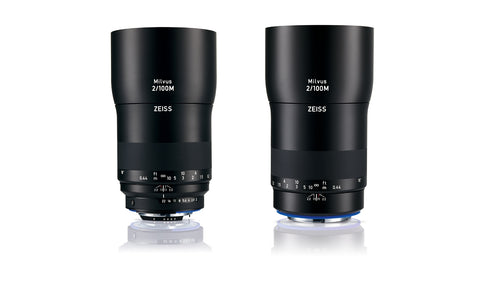
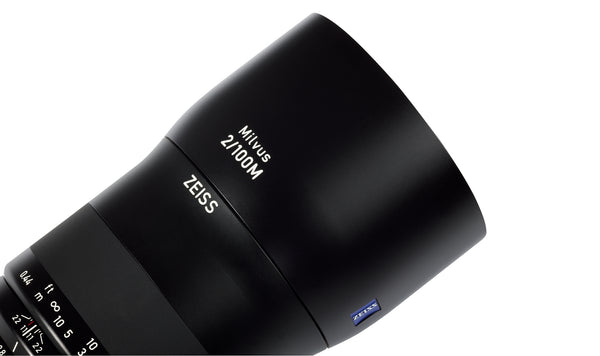
Zeiss Milvus 2/100M ZF.2 - Nikon Mount
$ 1,918.00
Zeiss Milvus 2/100M ZF.2 - Nikon Mount
Zeiss SKU: 000000-2096-562 | Helix SKU: ZS2096562
Overview
Whether in its role as a high-precision reproduction lens for technical applications or as a traditional, moderate tele-lens for portraits with shallow depth of field, the ZEISS Milvus 2/100M allows you to delve into both worlds.
The ZEISS Milvus 2/100M of the type ZEISS Makro-Planar is currently the fastest 100 mm macro lens on the market and closes the gap between long range and breathtaking close-up shots. This lens bridges distances and allows unique image compositions. This lens is ideal when you need some distance between your camera and your subject, e.g.during a portrait shoot. Its precise mechanical components with a large focus throw permit precise control which is particularly important for macro photography in the close-up range.
All lenses features a T*® antireflective coating from ZEISS. Outstanding stray light reduction is achieved by combining a number of optimally matched measures. In addition to the ZEISS T* coating, all lens edges are provided with a special pitch-black lacquer in a complex manual process. Light traps in mechanical components and specially designed surfaces are integrated to prevent the occurrence of reflections. Each focal length has its own individual optical design with the use of special types of glass displaying anomalous partial dispersion. This reduces the occurrence of color fringes at high-contrast edges of subjects to an absolute minimum.
The excellent image performance of the ZEISS Milvus Lenses is sharply focused on the requirements of current and future high-performance digital cameras. Thanks to the low level of stray light allowed by the lens design, high-contrast images are also possible with increasing high dynamic ranges of the sensors (HDR). The minimization of coma, astigmatism and spherical aberrations enables constantly high resolution over the entire image field. The optics are designed to ensure full utilization of the performance provided by high-resolution camera systems. Regardless of what the future holds – with the Milvus Lenses from ZEISS you are optimally equipped any time, any place.
Manually focusing a lens means controlling and therefore actively composing an image gently and precisely from your fingertips. Here, a good ergonomic design makes all the difference. ZEISS Milvus Lenses feature a large rotation angle which enables pinpoint focusing. The top-quality focusing mechanism moves smoothly without backlash, optimally supporting the photographer's creative interplay with the focal plane of high-speed fixed focal lengths. Changes are immediately visible in the viewfinder or display. The engraving in meters and feet, and the focus scale provide additional support for manual focusing. The silent, continuous aperture setting (de-click function with ZF.2 mount) and the long focusing range lay optimal conditions for video photography.
An optimized ergonomic design enables fatigue-free photography and reduces camera shake. The all-metal housing makes every adjustment a haptic experience. The dynamic, precise barrel design sets new trends in the world of camera lenses. However, the ZEISS Milvus Lenses will impress you not only due to their visual and haptic excellence, but also thanks to their inner qualities. Special seals for protection against dust and splashes expand the photographer's creative potential by guaranteeing the system's functional reliability even in environmentally difficult situations.
State-of-the-art camera systems and high-resolution digital image sensors are now demanding more and more performance from the lenses. The Floating Elements Design permits constantly high image performance in the focal plane – from the minimum object distance to infinity. This is accomplished by changing the axial distance between individual lens elements or element groups. The adjustment of the element spacing is coupled to the distance setting so that it always results in the right correction. The mechanical design of the ZEISS Milvus Lenses is highly complex and the workmanship must be extremely exact – both specialties of ZEISS.

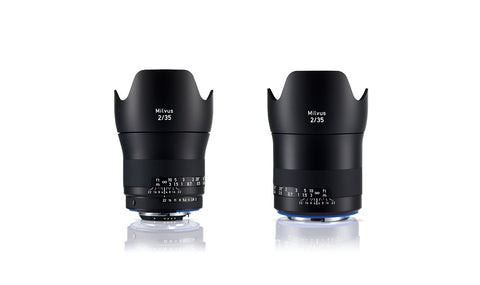
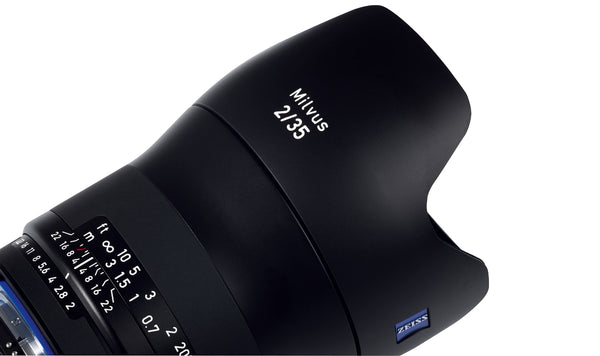
Zeiss Milvus 2/35 ZE - Canon Mount
$ 1,192.00
Zeiss Milvus 2/35 ZE - Canon Mount
Zeiss SKU: 000000-2096-555 | Helix SKU: ZS2096555
Overview
A split second can often decide whether you take a simple snapshot or create a unique image. The ZEISS Milvus 2/35 allows you to capture every decisive moment.
The ZEISS Milvus 2/35 of the type ZEISS Distagon is a moderate wide-angle lens that is ideal for capturing all scenes in their full natural brilliance – nothing will escape its attention, even in poor light.
Its compact design and fast, precise focusing make the lens particularly suitable for photojournalism. And thanks to its high performance and versatility, it is always ready for those unexpected moments.
All lenses features a T*® antireflective coating from ZEISS. Outstanding stray light reduction is achieved by combining a number of optimally matched measures. In addition to the ZEISS T* coating, all lens edges are provided with a special pitch-black lacquer in a complex manual process. Light traps in mechanical components and specially designed surfaces are integrated to prevent the occurrence of reflections. Each focal length has its own individual optical design with the use of special types of glass displaying anomalous partial dispersion. This reduces the occurrence of color fringes at high-contrast edges of subjects to an absolute minimum.
The excellent image performance of the ZEISS Milvus Lenses is sharply focused on the requirements of current and future high-performance digital cameras. Thanks to the low level of stray light allowed by the lens design, high-contrast images are also possible with increasing high dynamic ranges of the sensors (HDR). The minimization of coma, astigmatism and spherical aberrations enables constantly high resolution over the entire image field. The optics are designed to ensure full utilization of the performance provided by high-resolution camera systems. Regardless of what the future holds – with the Milvus Lenses from ZEISS you are optimally equipped any time, any place.
Manually focusing a lens means controlling and therefore actively composing an image gently and precisely from your fingertips. Here, a good ergonomic design makes all the difference. ZEISS Milvus Lenses feature a large rotation angle which enables pinpoint focusing. The top-quality focusing mechanism moves smoothly without backlash, optimally supporting the photographer's creative interplay with the focal plane of high-speed fixed focal lengths. Changes are immediately visible in the viewfinder or display. The engraving in meters and feet, and the focus scale provide additional support for manual focusing. The silent, continuous aperture setting (de-click function with ZF.2 mount) and the long focusing range lay optimal conditions for video photography.
An optimized ergonomic design enables fatigue-free photography and reduces camera shake. The all-metal housing makes every adjustment a haptic experience. The dynamic, precise barrel design sets new trends in the world of camera lenses. However, the ZEISS Milvus Lenses will impress you not only due to their visual and haptic excellence, but also thanks to their inner qualities. Special seals for protection against dust and splashes expand the photographer's creative potential by guaranteeing the system's functional reliability even in environmentally difficult situations.
State-of-the-art camera systems and high-resolution digital image sensors are now demanding more and more performance from the lenses. The Floating Elements Design permits constantly high image performance in the focal plane – from the minimum object distance to infinity. This is accomplished by changing the axial distance between individual lens elements or element groups. The adjustment of the element spacing is coupled to the distance setting so that it always results in the right correction. The mechanical design of the ZEISS Milvus Lenses is highly complex and the workmanship must be extremely exact – both specialties of ZEISS.
Originally developed for SLR cameras requiring a long back focal distance for short focal lengths because of the mirror box (the distance between the back lens element and the film plane must be considerably longer than the focal length), the Distagon lenses (retrofocus design) are also ideal for mirrorless system cameras thanks to their optimized ray path. Even with longer focal lengths, the high-performance Distagon optical design enables consistently good correction all the way to the corners of the image and very low field curvature.
Specifications
| Performance | Focal length | 35 mm |
| Aperture range | f/2.0 – f/22 | |
| Camera mount | Canon EF-Mount* (ZE) | Nikon F-Mount* (ZF.2) | |
| Format compatibility | Full Frame | |
| Focusing range | 0,30 m (11.8") - ∞ | |
| Free working distance | 0,18 m (7.09") - ∞ | |
| Angular field** (diag. | horiz. | vert.) | 62° / 53° / 37° | |
| Diameter of image field | 43 mm (1.69") | |
| Coverage at close range (MOD)** | 128 x 191 mm (5.04 x 7.52") | |
| Image ratio at minimum object distance | 1 : 5.3 | |
| Lens elements | groups | 9 / 7 | |
| Flange focal distance | ZE: 44 mm (1.73") | ZF.2: 46 mm (1.83") | |
| Entrance pupil position (front of image plane) | 86 mm (3.39") | |
| Features | Autofocus | – |
| Image Stabilization | – | |
| Physical | Filter thread | M58 x 0.75 |
| Rotation angle of focusing ring | 113° | |
| Diameter max. | ZE: 77 mm (3.03") | ZF.2: 77 mm (3.03") | |
| Diameter of focusing ring | ZE: 73 mm (2.90") | ZF.2: 68 mm (2.69") | |
| Length (with lens caps) | ZE: 99 mm (3.92") | ZF.2: 97 mm (3.82") | |
| Length (without lens caps) | ZE: 83 mm (3.27") | ZF.2: 81 mm (3.20") | |
| Weight | ZE: 702 g (24.76 oz) | ZF.2: 649 g (22.89 oz) |

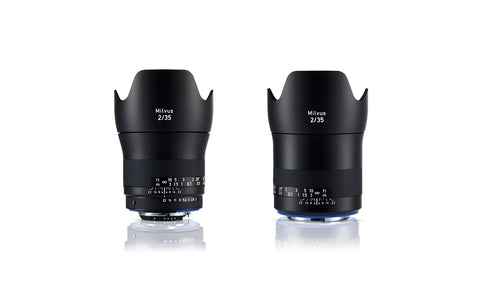
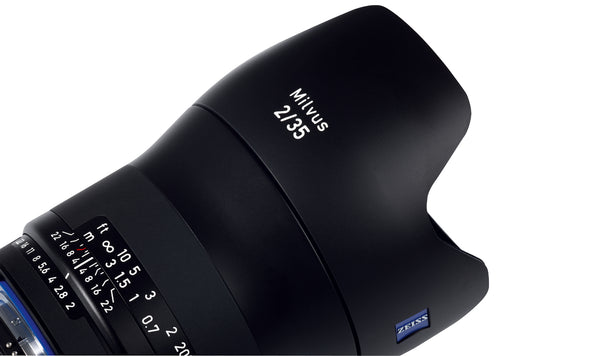
Zeiss Milvus 2/35 ZF.2 - Nikon Mount
$ 1,117.00 - Sold Out
Zeiss Milvus 2/35 ZF.2 - Nikon Mount
Zeiss SKU: 000000-2096-554 | Helix SKU: ZS2096554
Overview
A split second can often decide whether you take a simple snapshot or create a unique image. The ZEISS Milvus 2/35 allows you to capture every decisive moment.
The ZEISS Milvus 2/35 of the type ZEISS Distagon is a moderate wide-angle lens that is ideal for capturing all scenes in their full natural brilliance – nothing will escape its attention, even in poor light.
Its compact design and fast, precise focusing make the lens particularly suitable for photojournalism. And thanks to its high performance and versatility, it is always ready for those unexpected moments.
All lenses features a T*® antireflective coating from ZEISS. Outstanding stray light reduction is achieved by combining a number of optimally matched measures. In addition to the ZEISS T* coating, all lens edges are provided with a special pitch-black lacquer in a complex manual process. Light traps in mechanical components and specially designed surfaces are integrated to prevent the occurrence of reflections. Each focal length has its own individual optical design with the use of special types of glass displaying anomalous partial dispersion. This reduces the occurrence of color fringes at high-contrast edges of subjects to an absolute minimum.
The excellent image performance of the ZEISS Milvus Lenses is sharply focused on the requirements of current and future high-performance digital cameras. Thanks to the low level of stray light allowed by the lens design, high-contrast images are also possible with increasing high dynamic ranges of the sensors (HDR). The minimization of coma, astigmatism and spherical aberrations enables constantly high resolution over the entire image field. The optics are designed to ensure full utilization of the performance provided by high-resolution camera systems. Regardless of what the future holds – with the Milvus Lenses from ZEISS you are optimally equipped any time, any place.
Manually focusing a lens means controlling and therefore actively composing an image gently and precisely from your fingertips. Here, a good ergonomic design makes all the difference. ZEISS Milvus Lenses feature a large rotation angle which enables pinpoint focusing. The top-quality focusing mechanism moves smoothly without backlash, optimally supporting the photographer's creative interplay with the focal plane of high-speed fixed focal lengths. Changes are immediately visible in the viewfinder or display. The engraving in meters and feet, and the focus scale provide additional support for manual focusing. The silent, continuous aperture setting (de-click function with ZF.2 mount) and the long focusing range lay optimal conditions for video photography.
An optimized ergonomic design enables fatigue-free photography and reduces camera shake. The all-metal housing makes every adjustment a haptic experience. The dynamic, precise barrel design sets new trends in the world of camera lenses. However, the ZEISS Milvus Lenses will impress you not only due to their visual and haptic excellence, but also thanks to their inner qualities. Special seals for protection against dust and splashes expand the photographer's creative potential by guaranteeing the system's functional reliability even in environmentally difficult situations.
State-of-the-art camera systems and high-resolution digital image sensors are now demanding more and more performance from the lenses. The Floating Elements Design permits constantly high image performance in the focal plane – from the minimum object distance to infinity. This is accomplished by changing the axial distance between individual lens elements or element groups. The adjustment of the element spacing is coupled to the distance setting so that it always results in the right correction. The mechanical design of the ZEISS Milvus Lenses is highly complex and the workmanship must be extremely exact – both specialties of ZEISS.
Originally developed for SLR cameras requiring a long back focal distance for short focal lengths because of the mirror box (the distance between the back lens element and the film plane must be considerably longer than the focal length), the Distagon lenses (retrofocus design) are also ideal for mirrorless system cameras thanks to their optimized ray path. Even with longer focal lengths, the high-performance Distagon optical design enables consistently good correction all the way to the corners of the image and very low field curvature.
Specificaitons
| Performance | Focal length | 35 mm |
| Aperture range | f/2.0 – f/22 | |
| Camera mount | Canon EF-Mount* (ZE) | Nikon F-Mount* (ZF.2) | |
| Format compatibility | Full Frame | |
| Focusing range | 0,30 m (11.8") - ∞ | |
| Free working distance | 0,18 m (7.09") - ∞ | |
| Angular field** (diag. | horiz. | vert.) | 62° / 53° / 37° | |
| Diameter of image field | 43 mm (1.69") | |
| Coverage at close range (MOD)** | 128 x 191 mm (5.04 x 7.52") | |
| Image ratio at minimum object distance | 1 : 5.3 | |
| Lens elements | groups | 9 / 7 | |
| Flange focal distance | ZE: 44 mm (1.73") | ZF.2: 46 mm (1.83") | |
| Entrance pupil position (front of image plane) | 86 mm (3.39") | |
| Features | Autofocus | – |
| Image Stabilization | – | |
| Physical | Filter thread | M58 x 0.75 |
| Rotation angle of focusing ring | 113° | |
| Diameter max. | ZE: 77 mm (3.03") | ZF.2: 77 mm (3.03") | |
| Diameter of focusing ring | ZE: 73 mm (2.90") | ZF.2: 68 mm (2.69") | |
| Length (with lens caps) | ZE: 99 mm (3.92") | ZF.2: 97 mm (3.82") | |
| Length (without lens caps) | ZE: 83 mm (3.27") | ZF.2: 81 mm (3.20") | |
| Weight | ZE: 702 g (24.76 oz) | ZF.2: 649 g (22.89 oz) |

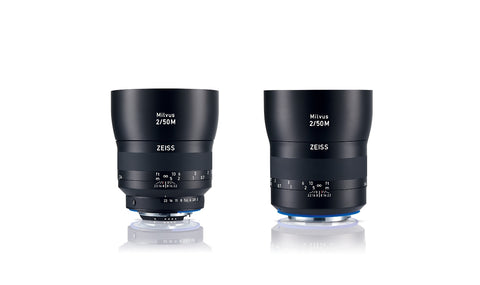
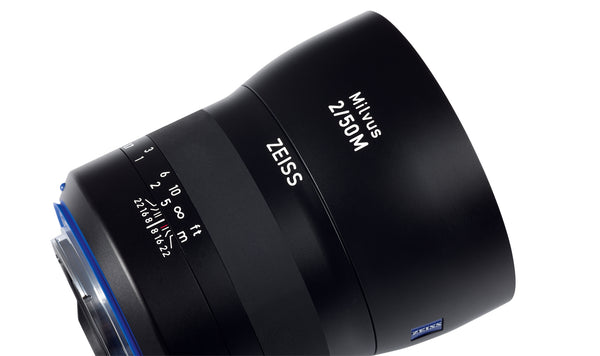
Zeiss Milvus 2/50M ZE - Canon Mount
$ 1,283.00
Zeiss Milvus 2/50M ZE - Canon Mount
Zeiss SKU: 000000-2096-559 | Helix SKU: ZS2096559
Overview
Enjoy a big picture of the tiny world: the ZEISS Milvus 2/50M can even transport you to the cosmos mirrored in a small drop of water. As a macro lens, it is the perfect solution for the close range. Used as a standard lens, it portrays the world in all its natural perspectives.
Breathtaking details in close-up and traditional portraits are the strengths of the ZEISS Milvus 2/50M of the type ZEISS Makro-Planar. Thanks to its excellent performance at all ranges this macro lens can be used for a wide variety of applications. Further optimization of the lens coating reduces ghosting and flare effects in critical light situations. The currently fastest 50 mm macro lens on the market will let you highlight even the smallest detail in the foreground or background.
All lenses features a T*® antireflective coating from ZEISS. Outstanding stray light reduction is achieved by combining a number of optimally matched measures. In addition to the ZEISS T* coating, all lens edges are provided with a special pitch-black lacquer in a complex manual process. Light traps in mechanical components and specially designed surfaces are integrated to prevent the occurrence of reflections. Each focal length has its own individual optical design with the use of special types of glass displaying anomalous partial dispersion. This reduces the occurrence of color fringes at high-contrast edges of subjects to an absolute minimum.
The excellent image performance of the ZEISS Milvus Lenses is sharply focused on the requirements of current and future high-performance digital cameras. Thanks to the low level of stray light allowed by the lens design, high-contrast images are also possible with increasing high dynamic ranges of the sensors (HDR). The minimization of coma, astigmatism and spherical aberrations enables constantly high resolution over the entire image field. The optics are designed to ensure full utilization of the performance provided by high-resolution camera systems. Regardless of what the future holds – with the Milvus Lenses from ZEISS you are optimally equipped any time, any place.
Manually focusing a lens means controlling and therefore actively composing an image gently and precisely from your fingertips. Here, a good ergonomic design makes all the difference. ZEISS Milvus Lenses feature a large rotation angle which enables pinpoint focusing. The top-quality focusing mechanism moves smoothly without backlash, optimally supporting the photographer's creative interplay with the focal plane of high-speed fixed focal lengths. Changes are immediately visible in the viewfinder or display. The engraving in meters and feet, and the focus scale provide additional support for manual focusing. The silent, continuous aperture setting (de-click function with ZF.2 mount) and the long focusing range lay optimal conditions for video photography.
An optimized ergonomic design enables fatigue-free photography and reduces camera shake. The all-metal housing makes every adjustment a haptic experience. The dynamic, precise barrel design sets new trends in the world of camera lenses. However, the ZEISS Milvus Lenses will impress you not only due to their visual and haptic excellence, but also thanks to their inner qualities. Special seals for protection against dust and splashes expand the photographer's creative potential by guaranteeing the system's functional reliability even in environmentally difficult situations.
State-of-the-art camera systems and high-resolution digital image sensors are now demanding more and more performance from the lenses. The Floating Elements Design permits constantly high image performance in the focal plane – from the minimum object distance to infinity. This is accomplished by changing the axial distance between individual lens elements or element groups. The adjustment of the element spacing is coupled to the distance setting so that it always results in the right correction. The mechanical design of the ZEISS Milvus Lenses is highly complex and the workmanship must be extremely exact – both specialties of ZEISS.
The Planar lens design is the most successful – and most frequently copied – camera lens design of all time. Modifications to the tried-and-tested six-lens basic type ensure that it achieves the high imaging quality required by modern sensors. Lenses with a Planar optical design enable consistent performance across a large range of image scales – the key requirement for universal macro-lenses.
Specifications
| Performance | Focal length | 50 mm |
| Aperture range | f/2.0 – f/22 | |
| Camera mount | Canon EF-Mount* (ZE) | Nikon F-Mount* (ZF.2) | |
| Format compatibility | Full Frame | |
| Focusing range | 0,24 m (9.44") - ∞ | |
| Free working distance | 0,10 m (3.93") - ∞ | |
| Angular field** (diag. | horiz. | vert.) | 45° / 38° / 26° | |
| Diameter of image field | 43 mm (1.69") | |
| Coverage at close range (MOD)** | 48 x 72 mm (1.89 x 2.83") | |
| Image ratio at minimum object distance | 1 : 2 | |
| Lens elements | groups | 8 / 6 | |
| Flange focal distance | ZE: 44 mm (1.73") | ZF.2: 46 mm (1.83") | |
| Entrance pupil position (front of image plane) | 55 mm (2.19") | |
| Features | Autofocus | – |
| Image Stabilization | – | |
| Physical | Filter thread | M67 x 0.75 |
| Rotation angle of focusing ring | 303° | |
| Diameter max. | ZE: 81 mm (3.19") | ZF.2: 81 mm (3.18") | |
| Diameter of focusing ring | ZE: 79 mm (3.11") | ZF.2: 80 mm (3.07") | |
| Length (with lens caps) | ZE: 90 mm (3.54") | ZF.2: 88 mm (3.45") | |
| Length (without lens caps) | ZE: 75 mm (2.96") | ZF.2: 73 mm (2.87") | |
| Weight | ZE: 730 g (25.75 oz) | ZF.2: 660 g (23.28 oz) |

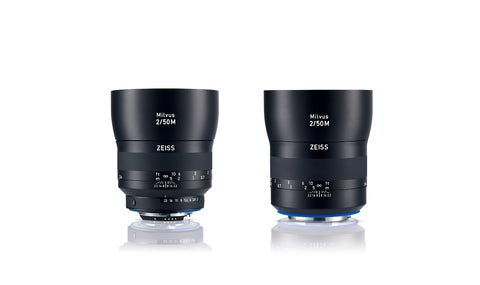
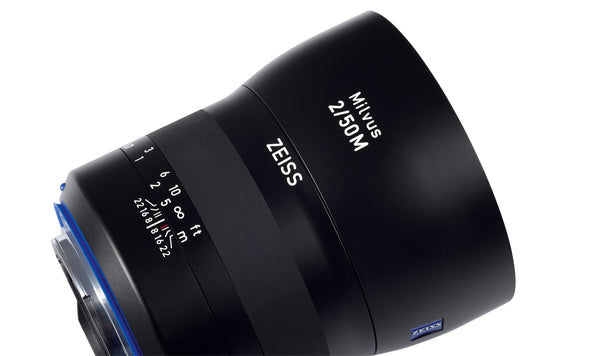
Zeiss Milvus 2/50M ZF.2 - Nikon Mount
$ 1,358.00
Zeiss Milvus 2/50M ZF.2 - Nikon Mount
Zeiss SKU: 000000-2096-558 | Helix SKU: ZS2096558
Overview
Enjoy a big picture of the tiny world: the ZEISS Milvus 2/50M can even transport you to the cosmos mirrored in a small drop of water. As a macro lens, it is the perfect solution for the close range. Used as a standard lens, it portrays the world in all its natural perspectives.
Breathtaking details in close-up and traditional portraits are the strengths of the ZEISS Milvus 2/50M of the type ZEISS Makro-Planar. Thanks to its excellent performance at all ranges this macro lens can be used for a wide variety of applications. Further optimization of the lens coating reduces ghosting and flare effects in critical light situations. The currently fastest 50 mm macro lens on the market will let you highlight even the smallest detail in the foreground or background.
All lenses features a T*® antireflective coating from ZEISS. Outstanding stray light reduction is achieved by combining a number of optimally matched measures. In addition to the ZEISS T* coating, all lens edges are provided with a special pitch-black lacquer in a complex manual process. Light traps in mechanical components and specially designed surfaces are integrated to prevent the occurrence of reflections. Each focal length has its own individual optical design with the use of special types of glass displaying anomalous partial dispersion. This reduces the occurrence of color fringes at high-contrast edges of subjects to an absolute minimum.
The excellent image performance of the ZEISS Milvus Lenses is sharply focused on the requirements of current and future high-performance digital cameras. Thanks to the low level of stray light allowed by the lens design, high-contrast images are also possible with increasing high dynamic ranges of the sensors (HDR). The minimization of coma, astigmatism and spherical aberrations enables constantly high resolution over the entire image field. The optics are designed to ensure full utilization of the performance provided by high-resolution camera systems. Regardless of what the future holds – with the Milvus Lenses from ZEISS you are optimally equipped any time, any place.
Manually focusing a lens means controlling and therefore actively composing an image gently and precisely from your fingertips. Here, a good ergonomic design makes all the difference. ZEISS Milvus Lenses feature a large rotation angle which enables pinpoint focusing. The top-quality focusing mechanism moves smoothly without backlash, optimally supporting the photographer's creative interplay with the focal plane of high-speed fixed focal lengths. Changes are immediately visible in the viewfinder or display. The engraving in meters and feet, and the focus scale provide additional support for manual focusing. The silent, continuous aperture setting (de-click function with ZF.2 mount) and the long focusing range lay optimal conditions for video photography.
An optimized ergonomic design enables fatigue-free photography and reduces camera shake. The all-metal housing makes every adjustment a haptic experience. The dynamic, precise barrel design sets new trends in the world of camera lenses. However, the ZEISS Milvus Lenses will impress you not only due to their visual and haptic excellence, but also thanks to their inner qualities. Special seals for protection against dust and splashes expand the photographer's creative potential by guaranteeing the system's functional reliability even in environmentally difficult situations.

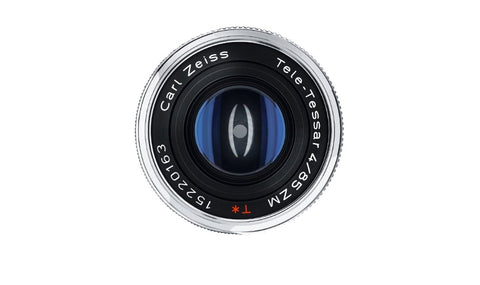

Zeiss Tele Tessar T* 4/85 ZM (B) Lens - Leica Mount - Black
$ 987.00
Zeiss Tele Tessar T* 4/85 ZM (B) Lens - Leica Mount - Black
Zeiss SKU: 1486-395 | Helix SKU: ZS1486395
Overview
This elegant Tele is the ideal travel companion for portrait and landscape photography and offers stunning images at nearly any distance.
Combined with a 35 mm Biogon wide-angle lens, the ZEISS Tele-Tessar T* 4/85 ZM makes for a classic combination for countless fascinating subjects. The image quality of the Tele-Tessar T* 4/85 ZM is equal to the high aperture models in the lens program. It is almost distortion free and adjusted to the field of curvature as well as to all other defects in color. With the shortest camera-to-subject distance of only 0.9 meters it delivers brilliant pictures at any distance. The all-metal mount and the robust construction turn it into a universal tele lens, even under extremely rough conditions.
Based on special types of high-index optical glass from the Schott Glaswerke and Dr. Paul Rudolph's optical design, the Tessar lens achieved world renown for its definition: the eagle eye of your camera. The ZEISS Tessar lens originally featured a four-lens design and is reflected in the product name: Tessar is derived from the Greek word tessares, meaning four.
Specifications
| Performance | Focal length | 85 mm |
| Aperture range | f/4.0 – f/22 | |
| Camera mount | Leica M-Mount* (ZM) | |
| Format compatibility | Full Frame | |
| Focusing range | 0,90 m (35.43") – ∞ | |
| Free working distance | ||
| Angular field** (diag. | horiz. | vert.) | 29° / 25° / 17° | |
| Diameter of image field | ||
| Coverage at close range (MOD)** | 320 x 210 mm (12.60 x 8.27") | |
| Image ratio at minimum object distance | 1 : 9 | |
| Lens elements | groups | 5 / 3 | |
| Flange focal distance | ||
| Entrance pupil position (front of image plane) | ||
| Features | Autofocus | – |
| Image Stabilization | – | |
| Physical | Filter thread | M43 x 0.75 |
| Rotation angle of focusing ring | ||
| Diameter max. | ||
| Diameter of focusing ring | ||
| Length (with lens caps) | ||
| Length (without lens caps) | 95 mm (3.74") | |
| Weight | 310 g (10.93 oz) |

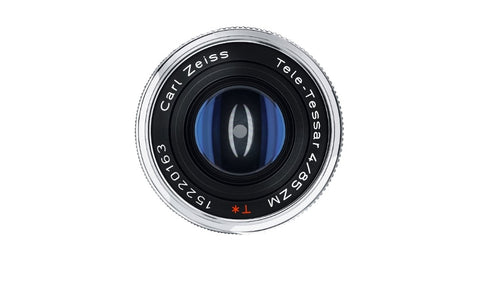
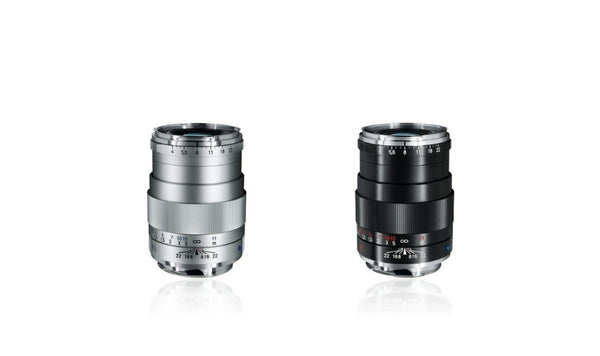
Zeiss Tele Tessar T* 4/85 ZM (S) Lens - Leica Mount - Silver
$ 987.00
Zeiss Tele Tessar T* 4/85 ZM (S) Lens - Leica Mount - Silver
Zeiss SKU: 1486-396 | Helix SKU: ZS1486396
Overview
This elegant Tele is the ideal travel companion for portrait and landscape photography and offers stunning images at nearly any distance.
Combined with a 35 mm Biogon wide-angle lens, the ZEISS Tele-Tessar T* 4/85 ZM makes for a classic combination for countless fascinating subjects. The image quality of the Tele-Tessar T* 4/85 ZM is equal to the high aperture models in the lens program. It is almost distortion free and adjusted to the field of curvature as well as to all other defects in color. With the shortest camera-to-subject distance of only 0.9 meters it delivers brilliant pictures at any distance. The all-metal mount and the robust construction turn it into a universal tele lens, even under extremely rough conditions.
Based on special types of high-index optical glass from the Schott Glaswerke and Dr. Paul Rudolph's optical design, the Tessar lens achieved world renown for its definition: the eagle eye of your camera. The ZEISS Tessar lens originally featured a four-lens design and is reflected in the product name: Tessar is derived from the Greek word tessares, meaning four.
Specifications
| Performance | Focal length | 85 mm |
| Aperture range | f/4.0 – f/22 | |
| Camera mount | Leica M-Mount* (ZM) | |
| Format compatibility | Full Frame | |
| Focusing range | 0,90 m (35.43") – ∞ | |
| Free working distance | ||
| Angular field** (diag. | horiz. | vert.) | 29° / 25° / 17° | |
| Diameter of image field | ||
| Coverage at close range (MOD)** | 320 x 210 mm (12.60 x 8.27") | |
| Image ratio at minimum object distance | 1 : 9 | |
| Lens elements | groups | 5 / 3 | |
| Flange focal distance | ||
| Entrance pupil position (front of image plane) | ||
| Features | Autofocus | – |
| Image Stabilization | – | |
| Physical | Filter thread | M43 x 0.75 |
| Rotation angle of focusing ring | ||
| Diameter max. | ||
| Diameter of focusing ring | ||
| Length (with lens caps) | ||
| Length (without lens caps) | 95 mm (3.74") | |
| Weight | 310 g (10.93 oz) |

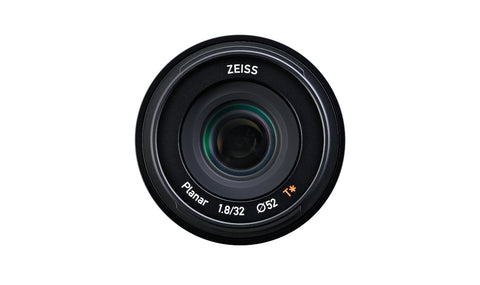
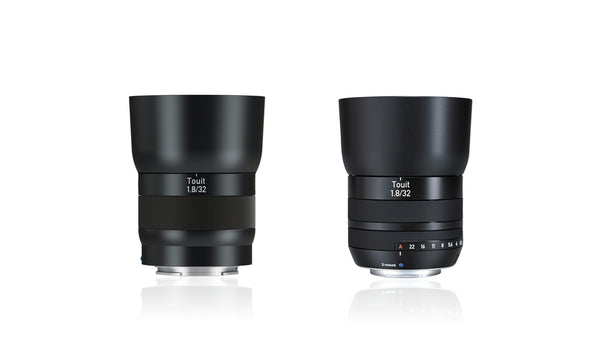
Zeiss Touit 1.8/32 E Lens - Sony E-Mount
$ 720.00 $ 648.00
Zeiss Touit 1.8/32 E Lens - Sony E-Mount
ZEISS SKU: 2030-678 | Helix SKU: ZS2030678
Overview
A compact standard focal length with autofocus, especially designed and constructed for compact APS-C cameras of the Sony Alpha series with E-Mount and Fujifilm X series. A lens that makes it so easy to spontaneously capture your special moments and preserve them in perfect pictures.
The best of two worlds. Just like a 50 mm lens in 35 mm photography, the ZEISS Touit® 1.8/32 offers the same angle of view as the human eye. However, optimised for use with APS-C format sensors, it is simultaneously a lens that is so light and compact that it can be taken along simply anywhere and everywhere you go. Whether you are shooting portraits, landscapes or spontaneous snapshots, you will never cease to be amazed by what a ZEISS Touit 1.8/32 can tease out of your camera. It is quite simply the ideal companion for capturing perspectives and colour- and lighting moods in perfect pictures.

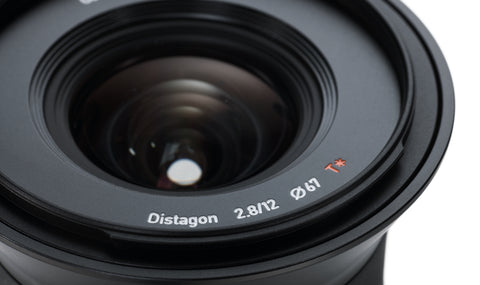
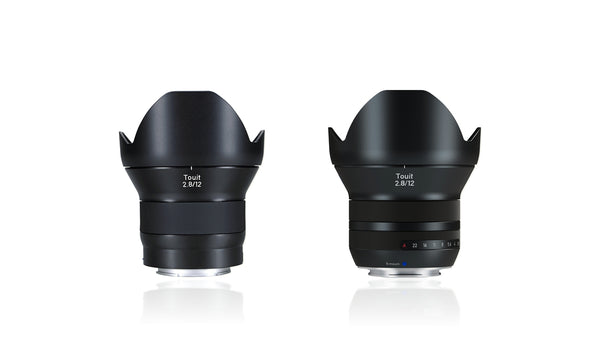
Zeiss Touit 2.8/12 E Lens - Sony E-Mount
$ 999.00 $ 899.00
Zeiss Touit 2.8/12 E Lens - Sony E-Mount
ZEISS SKU: 2030-526 | Helix SKU: ZS2030526
Overview
Thanks to the combination of one of the widest fields of view in APS-C format photography with fantastic imaging performance and light weight, this lens makes wide-angle photography even more fascinating.
With an angle of view of 99 degrees, the ZEISS Touit® 2.8/12 wide-angle lens will soon become a firm favourite, particularly for landscapes and architectural photography. Its unique ZEISS T*® multicoating guarantees maximum transmission and outstanding absorption of extraneous light. The result: breathtaking image quality from edge to edge and corner to corner of the entire image field. What’s more, all moving parts of the ZEISS Touit 2.8/12, conceived specifically for APS-C cameras of the Sony Alpha series with E-Mount and Fujifilm X Series, are engineered for extreme precision and a long service life. And finally, its strong and rigid metal bayonet mount makes it an absolutely dependable companion for many years to come.

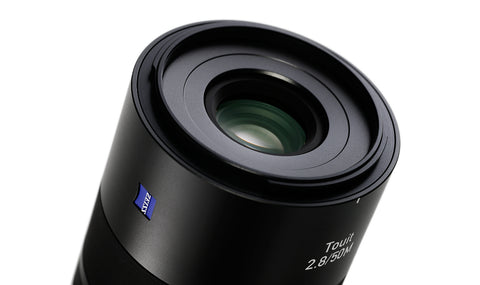
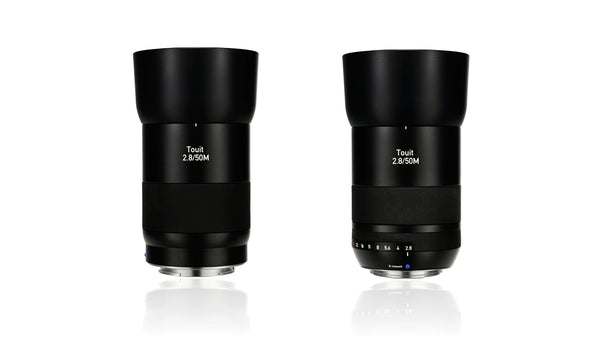
Zeiss Touit 2.8/50 Makro E Lens - Sony E-Mount
$ 999.00 $ 899.00
Zeiss Touit 2.8/50 Makro E Lens - Sony E-Mount
ZEISS SKU: 2030-680 | Helix SKU: ZS2030680
Overview
With its exceptional image performance up to a scale of 1:1, this macro lens is the ideal choice for extreme close ups. But it also comes into its own when shooting portraits or panoramas as a light tele-lens.
The delicate structure of a petal, the tiny hairs on a cat’s fur or the seductive lines at the corner of the eyes – whenever a shot is all about the minute details, the ZEISS Touit® 2.8/50M will delight and inspire. It not only allows you to portray objects in their original size, but also provides for beautiful contrast between the pin sharp focus of the image and the softly sketched background thanks to its aperture of 2.8.

Smooth and reliable autofocus
The design of the autofocus system demands an extremely precise movement of certain lens elements. As the mass of the elements or groups to be moved within the optical system differs, various motor types may be installed. The focusing system of the Touit lenses is designed to guarantee robust and smooth autofocusing without any need for compromises or limitations in their optical design.
Information: To achieve maximum compatibility on APS-C cameras of the Sony Alpha series with E-Mount (AF in video mode) we highly recommend using the latest Sony firmware.

1:1 Macro Capability
The ZEISS Touit 2.8/50M lets you capture the smallest things and the tiniest details at their actual size. At its closest focusing distance, subjects sized 15x23 mm fill the frame with an impressive maximum reproduction ratio of 1:1. The imaging performance of the ZEISS Touit 2.8/50M is just as exceptional at such short distances as it is at medium and long distances. Minimum distortion, outstanding correction of chromatic aberrations, minimal image field curvature and excellent correction of coma and astigmatism allow true-to-life reproduction of any subject, particularly in combination with the high resolving power of modern sensors.

Full compatibility
The ZEISS Touit lenses are designed and constructed specifically for use on APS-C cameras of the Sony Alpha series with E-Mount and Fujifilm X series. The lenses are therefore fully compatible and support all camera functions, including autofocus.

Excellent resolution and high contrast
Richly saturated and vivid colours are a must in the creation of lasting impressions. However, stray light within an optical system leads to a lightening of the image that is particularly noticeable in the shadows. This reduces image contrast, with the result that exposures lack contrast and appear faded. To avoid this, ZEISS combines various specially developed technologies to reduce the undesirable effects of stray light.

Floating Elements Design
Today’s camera technologies and high-resolution sensors demand continuous improvement of lens performance. Thanks to the use of the latest floating element design principles, optical aberration effects in ZEISS lenses are reduced to a minimum throughout their entire focusing range. This is achieved by variation of the axial distance between individual lens elements or groups. This adjustment of the lens-to-lens distance is coupled to the distance setting to ensure correct compensation at all times. The mechanical construction of these lenses is extremely complex and they must be assembled with utmost precision – both of which are key competencies of ZEISS.
Specifications
Lens Design
ZEISS Touit 2.8/50M


Technical Specifications
ZEISS Touit 2.8/50M
| Performance | Focal length | 50 mm |
| Aperture range | f/2.8 – f/22 | |
| Camera mount | Sony E-Mount* | Fujifilm X-Mount* | |
| Format compatibility | APS-C | |
| Focusing range | 0,15 m (6.02") – ∞ | |
| Free working distance | 0,05 m (1.97 ″) – ∞ | |
| Angular field** (diag. | horiz. | vert.) | 31° / 26° / 18° | |
| Diameter of image field | 28 mm (1.11") | |
| Coverage at close range (MOD)** | 24 x 16 mm (0.93 x 0.61") | |
| Image ratio at minimum object distance | 1 : 1 | |
| Lens elements | groups | 14 / 11 | |
| Flange focal distance | E: 18 mm (0.71") | X: 18 mm (0.70") | |
| Entrance pupil position (front of image plane) | 67 mm (2.67") | |
| Features | Autofocus | + |
| Image Stabilization | – | |
| Physical | Filter thread | M52 x 0.75 |
| Rotation angle of focusing ring | 720° | |
| Diameter max. | E: 75 mm (2.95") | X: 75 mm (2.95") | |
| Diameter of focusing ring | E: 65 mm (2.56") | X: 65 mm (2.56") | |
| Length (with lens caps) | E: 104 mm (4.09") | X: 108 mm (4.25") | |
| Length (without lens caps) | E: 91 mm (3.58") | X: 91 mm (3.58") | |
| Weight | E: 290 g (0.64 lbs) | X: 290 g (0.64 lbs) |






















